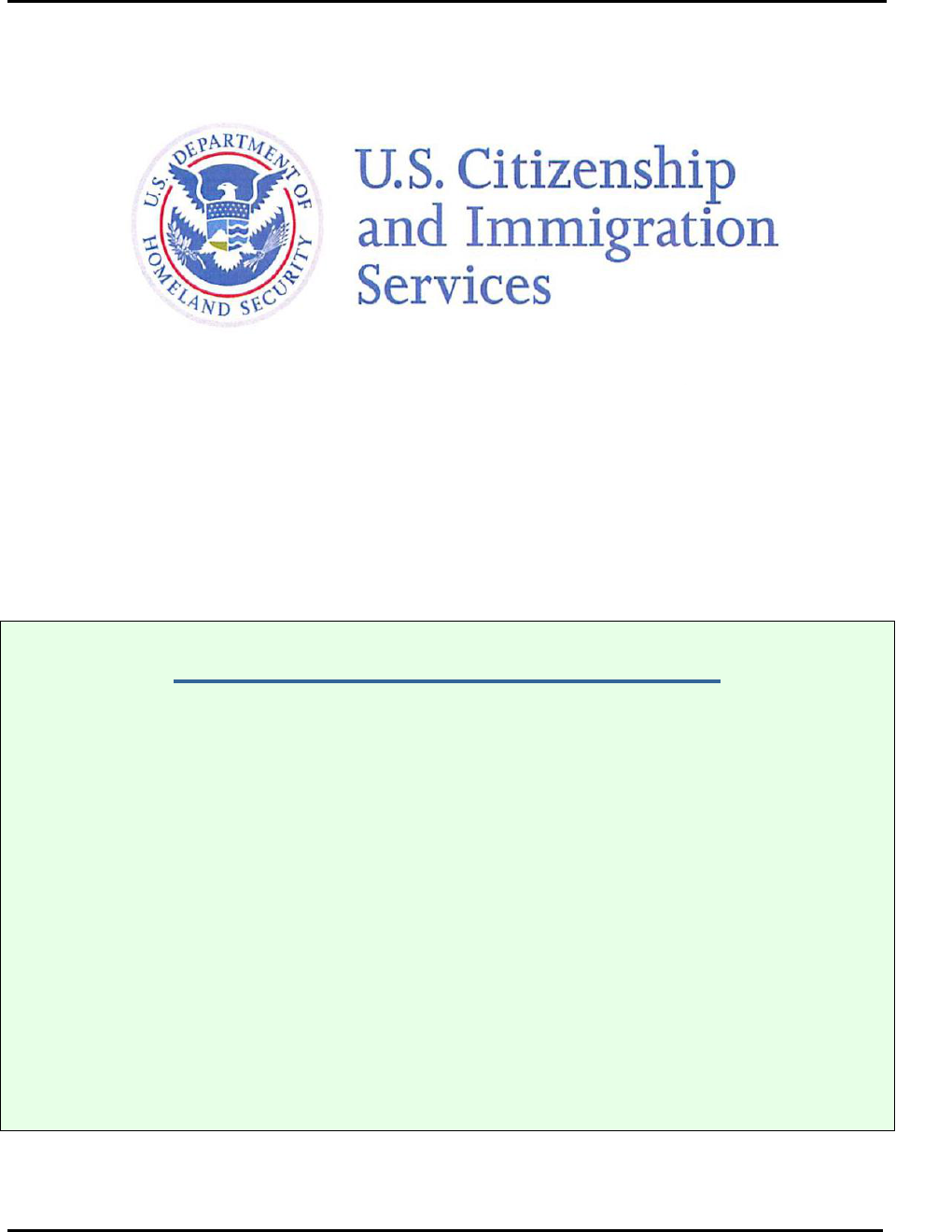
REFUGEE, ASYLUM, AND INTERNATIONAL OPERATIONS DIRECTORATE (RAIO)
DATE (see schedule of revisions): 7/20/2021
RAIO DIRECTORATE – OFFICER TRAINING
RAIO Combined Training Program
NEXUS –
PARTICULAR SOCIAL GROUP
TRAINING MODULE

Nexus – Particular Social Group
USCIS: RAIO Directorate – Officer Training
DATE (see schedule of revisions): 7/20/2021
RAIO Combined Training Program
Page 2 of 57
This Page Left Blank Intentionally

Nexus – Particular Social Group
USCIS: RAIO Directorate – Officer Training
DATE (see schedule of revisions): 7/20/2021
RAIO Combined Training Program
Page 3 of 57
RAIO Directorate – Officer Training / RAIO Combined Training Program
NEXUS – PARTICULAR SOCIAL GROUP
Training Module
MODULE DESCRIPTION:
This module discusses membership in a particular social group (PSG), one of the
protected grounds in the refugee definition codified in the Immigration and Nationality
Act. The discussion describes membership in a particular social group (PSG) and
examines its interpretation in administrative and judicial case law. The primary focus of
this module is the determination as to whether an applicant has established that past harm
suffered or future harm feared is on account of membership in a particular social group.
TERMINAL PERFORMANCE OBJECTIVE(S)
Given a request to adjudicate either a request for asylum or a request for refugee status,
the officer will be able to apply the law (statutes, regulations and case law) to determine
whether an applicant is eligible for the requested relief.
ENABLING PERFORMANCE OBJECTIVES
1. Explain factors to consider in determining whether persecution or feared persecution
is on account of membership in a particular social group.
•
INSTRUCTIONAL METHODS
• Interactive Presentation
• Discussion
• Practical Exercises
METHOD(S) OF EVALUATION
• Multiple-choice exam

Nexus – Particular Social Group
USCIS: RAIO Directorate – Officer Training
DATE (see schedule of revisions): 7/20/2021
RAIO Combined Training Program
Page 4 of 57
REQUIRED READING
1. Matter of M-E-V-G-, 26 I&N Dec. 227 (BIA 2014)
2. Matter of W-G-R-, 26 I&N Dec. 208 (BIA 2014)
3. Matter of A-B-, 28 I&N Dec. 307 (A.G. 2021)
4. Matter of A-R-C-G-, 26 I&N Dec. 388 (BIA 2014)
5. Matter of L-E-A-, 27 I&N Dec. 40 (BIA 2017)
Required Reading – International and Refugee Adjudications
Required Reading – Asylum Adjudications
ADDITIONAL RESOURCES
1. Matter of C-A-, 23 I&N Dec. 951 (BIA 2006)
2. Matter of Acosta, 19 I&N Dec. 211, 233-34 (BIA 1985)
3. Lynden D. Melmed, USCIS Chief Counsel. Guidance on Matter of C-A-,
Memorandum to Lori Scialabba, Associate Director, Refugee, Asylum and
International Operations (Washington, DC: January 12, 2007).
4. United Nations High Commissioner for Refugees, Guidelines on International
Protection: “Membership of a particular social group” within the context of Article
1A(2) of the 1951 Convention and/or its 1967 Protocol relating to the Status of
Refugees. HCR/GIP/02/02, 7 May 2002, 5 pp.
5. Phyllis Coven. INS Office of International Affairs. Considerations For Asylum
Officers Adjudicating Asylum Claims From Women (Gender Guidelines),
Memorandum to all INS Asylum Officers, HQASM Coordinators (Washington, DC:
26 May 1995), 19 p. See also RAIO Training Module, Gender-Related Claims.
6. Rosemary Melville. INS Office of International Affairs. Follow Up on Gender
Guidelines Training, Memorandum to Asylum Office Directors, SAOs, AOs
(Washington, DC: 7 July 1995), 8 p.
7. Paul W. Virtue. INS Office of General Counsel. Whether Somali Clan Membership
May Meet the Definition of Membership in a Particular Social Group under the INA,
Memorandum to Kathleen Thompson, INS Office of International Affairs
(Washington, DC: 9 December 1993), 7 p.
Additional Resources – International and Refugee Adjudications

Nexus – Particular Social Group
USCIS: RAIO Directorate – Officer Training
DATE (see schedule of revisions): 7/20/2021
RAIO Combined Training Program
Page 5 of 57
Additional Resources – Asylum Adjudications
CRITICAL TASKS
Task/ Skill # Task Description
ILR6
Knowledge of U.S. case law that impacts RAIO (3)
ILR9
Knowledge of policies and procedures for processing lesbian, gay, bisexual and
transgender (LGBT) claims (3)
ILR10
Knowledge of policies and procedures for processing gender-related claims (3)
ILR14
Knowledge of nexus to a protected characteristic (4)
ILR15
Knowledge of the elements of each protected characteristic (4)
DM2
Skill in applying legal, policy and procedural guidance (e.g., statutes, precedent
decisions, case law) to information and evidence) (5)
RI1
Skill in identifying issues of claim (4)
RI2
Skill in identifying the information required to establish eligibility (4)

Nexus – Particular Social Group
USCIS: RAIO Directorate – Officer Training
DATE (see schedule of revisions): 7/20/2021
RAIO Combined Training Program
Page 6 of 57
SCHEDULE OF REVISIONS
Date
Section
(Number and
Name)
Brief Description of Changes
Made By
11/6/2013
Summary (of
4/30/2013
edition)
Revised last sentence of paragraph 1 of
Summary and corrected corresponding
footnote # 114; added an additional sentence
as clarification.
J. Kochman
2/4/2014
Additional
Resources
Removed Dea Carpenter memo (not yet
accepted)
L. Gollub
(incorporated
by V. Conley
and J.
Stadnick)
7/27/2015
Throughout LP
Substantial revision of LP for updated case
law and new guidance:
ASM QA,
ASM
Training,
RAD TAQA,
RAIO
Training
12/20/2019
Entire Lesson
Plan; Added
Disclaimer;
Required
Readings
Minor edits to reflect changes in
organizational structure of RAIO; added
disclaimer textbox regarding updated case law
to p. 9; added required readings to p. 4; no
other substantive updates
RAIO
Training
7/20/2021
“Important Note
about Updated
Case Law”
Disclaimer;
Required
Readings
Updated to reflect vacatur of Matter of A-B-,
27 I&N Dec. 316 (A.G. 2018) (“A-B- I”),
Matter of A-B-, 28 I&N Dec. 199 (A.G. 2021)
(“A-B- II”), and Matter of L-E-A-, 27 I&N
Dec. 581 (A.G. 2019) (“L-E-A- II”); fixed
broken links
RAIO
Training,
OCC

Nexus – Particular Social Group
USCIS: RAIO Directorate – Officer Training
DATE (see schedule of revisions): 7/20/2021
RAIO Combined Training Program
Page 7 of 57
Table of Contents
1. INTRODUCTION .....................................................................................................................10
2. DOES THE APPLICANT POSSESS A PROTECTED CHARACTERISTIC? ...................................11
2.1 Is the Applicant a Member of a Particular Social Group? ...............................................11
2.2 General Principles for Formulating Particular Social Groups ..........................................18
3. IS THE PERSECUTION OR FEARED PERSECUTION “ON ACCOUNT OF” THE APPLICANT’S
PARTICULAR SOCIAL GROUP MEMBERSHIP? ......................................................................21
4. PRECEDENT DECISIONS (SPECIFIC GROUPS) .......................................................................22
4.1 Family Membership .........................................................................................................22
4.2 Clan Membership .............................................................................................................24
4.3 Age ...................................................................................................................................25
4.4 Gender ..............................................................................................................................26
4.4.1 Female Genital Mutilation (FGM) ................................................................................26
4.4.2 Widows ..........................................................................................................................27
4.4.3 Gender-Specific Dress Codes ........................................................................................28
4.5 Lesbian, Gay, Bisexual, Transgender, and Intersex (LGBTI) ..........................................29
4.6 Domestic Violence ...........................................................................................................30
4.6.1 Women Who Are Unable to Leave a Domestic Relationship or Women Who Are
Viewed as Property by Virtue of their Position within a Domestic Relationship .........30
4.6.2 Other Types of Domestic Relationships ........................................................................31
4.6.3 Children in Domestic Relationships ..............................................................................32
4.7 Ancestry ............................................................................................................................34
4.8 Individuals with Physical or Mental Disabilities .............................................................35
4.9 Unions ..............................................................................................................................36
4.10 Students and Professionals ...............................................................................................37
4.11 Small-Business Owners Indebted to Private Creditors ....................................................37
4.12 Landowners ......................................................................................................................37
4.13 Groups Based on “Wealth” or “Affluence” .....................................................................39

Nexus – Particular Social Group
USCIS: RAIO Directorate – Officer Training
DATE (see schedule of revisions): 7/20/2021
RAIO Combined Training Program
Page 8 of 57
4.14 Present or Former Employment in Either Law Enforcement or the Military ..................40
4.14.1 Former Military/Police Membership .............................................................................40
4.14.2 Current Military/Police Membership ............................................................................42
4.15 Drug Traffickers ...............................................................................................................43
4.16 Criminal Deportees ...........................................................................................................44
4.17 Persons Returning from the United States .......................................................................44
4.18 Tattooed Youth .................................................................................................................45
4.19 Individuals Resisting and Fearing Gang Recruitment, and Opposition to Gang Authority45
4.20 Non-Criminal Informants, Civilian Witnesses, and Assistance to Law Enforcement .....46
4.21 Gang Members .................................................................................................................50
4.22 Former Gang Members ....................................................................................................51
5. SUMMARY ..............................................................................................................................51

Nexus – Particular Social Group
USCIS: RAIO Directorate – Officer Training
DATE (see schedule of revisions): 7/20/2021
RAIO Combined Training Program
Page 9 of 57
Throughout this training module, you will come across references to adjudication-
specific supplemental information located at the end of the module, as well as links
to documents that contain adjudication-specific, detailed information. You are
responsible for knowing the information in the referenced material that pertains to
the adjudications you will be performing.
For easy reference, supplements for international and refugee adjudications are in
pink and supplements for asylum adjudications are in yellow.
You may also encounter references to the legacy Refugee Affairs Division (RAD)
and the legacy International Operations Division (IO). RAD has been renamed the
International and Refugee Affairs Division (IRAD) and has assumed much of the
workload of IO, which is no longer operating as a separate RAIO division.
Important Note about Updated Case Law
On June 16, 2021, the Attorney General issued a pair of decisions vacating Matter
of A-B-, 27 I&N Dec. 316 (A.G. 2018) (“A-B- I”), Matter of A-B-, 28 I&N Dec.
199 (A.G. 2021) (“A-B- II”), and Matter of L-E-A-, 27 I&N Dec. 581 (A.G. 2019)
(“L-E-A- II”) in their entirety. See Matter of A-B-, 28 I&N Dec. 307 (A.G. 2021)
and Matter of L-E-A-, 28 I&N Dec. 304 (A.G. 2021). Accordingly, RAIO officers
should not rely upon these vacated decisions or the associated USCIS Policy
Memoranda from July 11, 2018 (Matter of A-B-) and September 30, 2019 (Matter
of L-E-A-), or any other USCIS guidance or training materials that reference these
documents, to the extent they are based on the vacated decisions.
In both decisions, the Attorney General noted the President’s executive order
directing the Attorney General and the Secretary of Homeland Security to
promulgate joint regulations addressing the circumstances in which a person
should be considered a member of a particular social group. Matter of A-B-, 28
I&N Dec. at 308; Matter of L-E-A-, 28 I&N Dec. at 304-05 (citing Exec. Order No.
14010, § 4(c)(ii), 86 Fed. Reg. 8267, 8271 (Feb. 2, 2021)). As such, the particular
social group issues addressed by these decisions will be the subject of forthcoming
rulemaking, where they can be resolved with the benefit of a full record and public
comment.
Pending rulemaking, adjudicators are directed to follow pre-A-B- I precedent,
including Matter of A-R-C-G-, 26 I&N Dec. 388 (BIA 2014), which had been
overruled by the Attorney General in A-B- I. In Matter of A-R-C-G-, the Board of
Immigration Appeals (“BIA” or “Board”) held that “married women in Guatemala
who are unable to leave their relationship” can constitute a cognizable particular

Nexus – Particular Social Group
USCIS: RAIO Directorate – Officer Training
DATE (see schedule of revisions): 7/20/2021
RAIO Combined Training Program
Page 10 of 57
social group that forms the basis of a claim for asylum, depending on the facts and
evidence in the individual case. A-R-C-G- is discussed in more detail in Sections
2.1, Is the Applicant a Member of a Particular Social Group? and 4.6, Domestic
Violence, in this lesson plan. Adjudicators also should follow the guidance in
DHS’s brief to the Board in Matter of L-R-, which is discussed in Section 4.6,
Domestic Violence, in this lesson plan.
Similarly, adjudicators are directed to rely on pre-L-E-A- II precedent, including
Matter of L-E-A-, 27 I&N Dec. 40 (BIA 2017) (“L-E-A- I”). In that case, the BIA
held that the respondent’s father’s immediate family qualified as a particular social
group, reiterating its “long recognized” position “that family ties may meet the
requirements of a particular social group depending on the facts and circumstances
of the case.” Id. at 42. The BIA stated that not all attenuated family ties will satisfy
the particularity and social distinction criteria, and the analysis “will depend on the
nature and degree of the relationships involved and how those relationships are
regarded by the society in question.” Id. at 42-43. The BIA also upheld the
Immigration Judge’s finding that the cartel was not motivated to harm the
respondent on account of his family status. Rather, based on the specific facts in
the record, the persecutor was motivated to target the respondent because he was in
a position to provide access to his father’s store, where the cartel wanted to
increase its profits by selling contraband, and the respondent’s membership in his
family was an incidental reason for the harm. Id. at 46-47. Family-based particular
social groups are discussed in Sections 4.1, Family Membership, and 4.2, Clan
Membership, in this lesson plan.
Further guidance and substantive revisions to this lesson plan are forthcoming as of
the last revision date (see schedule of revisions). In the meantime, the “Required
Reading” list, above, has been updated to reflect the Board’s currently binding
decisions on these topics.
1. INTRODUCTION
The refugee definition at INA §101(a)(42) states that an individual is a refugee if he or
she establishes past persecution or a well-founded fear of future persecution on account
of one or more of the five protected grounds. All of the elements of the refugee definition
are reviewed in the RAIO Training Module, Refugee Definition. The requirements for an
applicant to establish eligibility based on past persecution are discussed in the module,
Persecution. The elements necessary to establish a well-founded fear of future
persecution are discussed in the module, Well-Founded Fear. The analysis of the
persecutor’s motive and the requirements needed to establish that persecution or feared
persecution is “on account of” race, religion, nationality, or political opinion are
discussed in the module, Nexus and the Protected Grounds (minus PSG).

Nexus – Particular Social Group
USCIS: RAIO Directorate – Officer Training
DATE (see schedule of revisions): 7/20/2021
RAIO Combined Training Program
Page 11 of 57
This module provides you with an understanding of the requirements needed to establish
whether persecution or feared persecution is “on account of” membership in a particular
social group (PSG).
The nexus analysis for particular social group claims is fundamentally the same as it is
for cases involving the other protected characteristics; you must determine:
1. whether the applicant possesses or is perceived to possess a protected characteristic;
and
2. whether the persecution or feared persecution is on account of that protected
characteristic.
2. DOES THE APPLICANT POSSESS A PROTECTED CHARACTERISTIC?
The first question is the starting point for all protected grounds – whether the applicant
possesses, or is perceived to possess, a protected characteristic: membership in a
particular social group. Membership in a particular social group may overlap with other
protected grounds, such as political opinion, and you should also consider whether the
applicant can establish eligibility based on a different protected ground.
For cases based on membership in a particular social group, the analysis is expanded,
requiring you to identify the characteristics that form the particular social group and
explain why persons with those characteristics form a particular social group within the
meaning of the refugee definition.
Determining whether a specific group constitutes a particular social group can be a
complicated task. Recognizing this complexity, the Board of Immigration Appeals has set
forth a three-part test for evaluating whether a group meets the definition of a particular
social group.
1
While looking to precedential decisions from the Board and the circuit
courts of appeals may help inform your decision, you must apply the analysis discussed
below to the facts of each individual case.
2.1 Is the Applicant a Member of a Particular Social Group?
An applicant who is seeking asylum or refugee status based on membership in a
particular social group must establish that the group is (1) composed of members who
1
Matter of M-E-V-G-, 26 I&N Dec. 227 (BIA 2014); Matter of W-G-R-, 26 I&N Dec. 208 (BIA 2014).

Nexus – Particular Social Group
USCIS: RAIO Directorate – Officer Training
DATE (see schedule of revisions): 7/20/2021
RAIO Combined Training Program
Page 12 of 57
share a common immutable characteristic, (2) socially distinct within the society in
question, and (3) defined with particularity.
2
All three elements must be established.
It is important to remember that membership in a particular social group may be imputed
to an applicant who is not, in fact, a member of a particular social group.
Step One: Common Immutable Characteristic
The group must comprise individuals who share a common, immutable characteristic,
meaning it is one that the members of the group either cannot change, or should not be
required to change because it is fundamental to each member’s identity or conscience.
3
The defining characteristic can be a shared innate characteristic, a shared past experience,
or a social or other status.
4
Unchangeable Characteristics
Unchangeable characteristics are traits that cannot be changed. Some examples of
characteristics that cannot be changed include innate ones, like gender, race, ethnicity,
skin color, and family relationships.
5
Some of these characteristics are biological traits of
a person. Others might be shared past experiences that cannot be changed because a
person is unable to change the past.
Fundamental Characteristics
Fundamental characteristics are traits, beliefs, or statuses that a person should not be
required to change because they are essential to the individual’s identity or conscience. In
analyzing this type of claim, you should consider both how the applicant experiences the
trait as part of his or her identity and whether the trait is fundamental from an objective
point of view. With regard to the latter, you may consider whether human rights norms
suggest the characteristic is fundamental. An example of a shared trait that is fundamental
to an individual’s identity or conscience is having intact genitalia in the female genital
mutilation (FGM) context. In contrast, even though an applicant may consider being a
member of a terrorist or criminal organization as being fundamental to his or her identity
or conscience, there is no basic human right to pursue such an association, and it would
not be considered fundamental from an objective point of view.
6
2
Matter of M-E-V-G-, 26 I&N Dec. at 237; Matter of W-G-R-, 26 I&N Dec. at 212-218; see also Matter of A-R-C-G-, 26 I&N
Dec. 388 (BIA 2014) (applying to a domestic violence scenario the three-part test put forth in Matter of M-E-V-G- and Matter of
W-G-R-.)
3
Matter of Acosta, 19 I&N Dec. 211, 233 (BIA 1985).
4
Id. at 233-34; Matter of W-G-R-, 26 I&N Dec. at 212-13; Matter of A-R-C-G-, 26 I&N Dec. at 392-393.
5
See Fatin v. INS, 12 F.3d 1233, 1239 (3d Cir. 1993); Matter of Kasinga, 21 I&N Dec. 357, 366 (BIA 1996).
6
See Arteaga v. Mukasey, 511 F.3d 940, 946 (9th Cir. 2007) (the court noted, “we would be hard-pressed to agree with the
suggestion that one who voluntarily associates with a vicious street gang that participates in violent criminal activity does so for
reasons so fundamental to ‘human dignity’ that he should not be forced to forsake the association”).

Nexus – Particular Social Group
USCIS: RAIO Directorate – Officer Training
DATE (see schedule of revisions): 7/20/2021
RAIO Combined Training Program
Page 13 of 57
In Matter of Acosta, 19 I&N Dec. 211, 234 (BIA 1988), the Board explained that the
unchangeable characteristic or fundamental characteristic is part of the definition of a
particular social group because each of the other four protected grounds describe
persecution aimed at an immutable characteristic.
7
Therefore, the Board interpreted the
term “particular social group” consistently with the other grounds of persecution in the
INA, explaining that “the concept that refuge is restricted to individuals who are either
unable by their own actions, or as a matter of conscience should not be required, to avoid
persecution.”
8
Assumption of Risk Considerations
In some cases, the applicant’s voluntary assumption of an extraordinary risk of serious
harm in taking on the trait that defines the group may be evidence of fundamentality.
9
An
applicant’s decision to assume significant risks can, in some cases, provide evidence that
the belief or trait is fundamental to the applicant’s identity or conscience.
10
The relevance
of an applicant’s voluntary assumption of risk must be considered on a case-by-case
basis. Not all individuals assume the risk of a particular activity because the activity is
fundamental to their identity.
11
For example, an individual may assume the risk of a
particular activity for monetary gain, and in such a case that assumption of risk may
undercut fundamentality.
12
Step Two: Social Distinction
A group’s shared characteristic must be perceived as distinct by the relevant society.
13
This element has sometimes been referred to as “social visibility.” However, in its rulings
in Matter of M-E-V-G-, 26 I&N Dec. 227 (BIA 2014) and Matter of W-G-R-, 26 I&N
Dec. 208 (BIA 2014), the Board renamed “social visibility” as “social distinction” to
avoid confusion.
14
The Board emphasized that “social distinction” does not require the
shared characteristic to be seen by society (i.e., visible); instead the group characteristic
must be perceived as distinct by society.
15
There must be evidence indicating “that a
7
Matter of Acosta, 19 I&N Dec. at 233-34.
8
Id.
9
See Lynden D. Melmed, USCIS Chief Counsel, Guidance on Matter of C-A-, Memorandum to Lori Scialabba, Associate
Director, Refugee, Asylum and International Operations (Washington, DC: January 12, 2007).
10
Id. at 3.
11
Lynden D. Melmed, USCIS Chief Counsel, Guidance on Matter of C-A-, Memorandum to Lori Scialabba, Associate Director,
Refugee, Asylum and International Operations (Washington, DC: January 12, 2007).
12
Id.
13
Matter of W-G-R-, 26 I&N Dec. at 216.
14
Matter of M-E-V-G-, 26 I&N Dec. at 240; Matter of W-G-R-, 26 I&N Dec. at 216.
15
Matter of M-E-V-G-, 26 I&N Dec. at 240; Matter of W-G-R-, 26 I&N Dec. at 216.

Nexus – Particular Social Group
USCIS: RAIO Directorate – Officer Training
DATE (see schedule of revisions): 7/20/2021
RAIO Combined Training Program
Page 14 of 57
society in general perceives, considers, or recognizes persons” as a group.
16
This
requirement can be met by showing that the society in question sets apart or differentiates
between people who possess the shared belief or trait and people who do not, even if
individual group members are not visibly recognized as group members. In other words,
if the common immutable characteristic were known, those with the characteristic in the
society in question would be meaningfully distinguished from those who do not have it.
17
The Board’s interpretation of “social distinction” is consistent with USCIS’s
longstanding interpretation of the term.
18
In some circumstances, members of a group may be visibly recognizable, but society may
also consider persons to be a group without being able to identify the members by sight.
Board cases have recognized groups that were not ocularly visible. For instance, in
Matter of Kasinga, 21 I&N Dec. 357, 365-66 (BIA 1996), the Board determined that
young women from a certain ethnic group in Togo who have not been previously
subjected to FGM but are opposed to it constitute a particular social group. In Matter of
Toboso-Alfonso, 20 I&N Dec. 819, 822-23 (BIA 1990) the Board held that
“homosexuals” in Cuba were a particular social group. In Matter of Fuentes, 19 I&N
Dec. 658 (BIA 1988), the Board concluded that former national police members could be
a particular social group in some circumstances. These cases illustrate the point that
ocular visibility is not required. In such cases, it may not be easy or possible to identify
who has not been subjected to or is opposed to FGM, who is gay, or who is a former
member of the national police.
19
Social distinction must be evaluated on a case-by-case basis and society-by-society
basis
As previously noted, for social distinction, there must be evidence showing that society in
general perceives or considers people who share a particular characteristic as distinct.
20
Evidence such as country conditions, witness testimony, and press accounts may
establish that a group is distinct.
21
The Board has emphasized that the social distinction
determination must be made on a case-by-case basis.
22
Laws, policies, or cultural
practices of a society, as well as governmental or non-governmental programs targeting
certain groups, may also establish social distinction. For instance, in evaluating whether
16
Matter of W-G-R-, 26 I&N Dec. at 217.
17
Matter of M-E-V-G-, 26 I&N Dec. at 238.
18
See, e.g., Lynden D. Melmed, USCIS Chief Counsel, Guidance on Matter of C-A-, Memorandum to Lori Scialabba, Associate
Director, Refugee, Asylum and International Operations (Washington, DC: January 12, 2007).
19
Matter of M-E-V-G-, 26 I&N Dec. at 240.
20
Matter of W-G-R-, 26 I&N Dec. at 217 (BIA 2014).
21
Matter of M-E-V-G-, 26 I&N Dec. at 244 (BIA 2014); see also Matter of A-R-C-G-, 26 I&N Dec. 388, 394 (BIA 2014)
(discussing the types of evidence that may show social distinction in domestic violence-related particular social groups, including
evidence that the society recognizes the need to offer protection to victims of domestic violence and other sociopolitical factors).
22
Matter of M-E-V-G-, 26 I&N Dec. at 242.

Nexus – Particular Social Group
USCIS: RAIO Directorate – Officer Training
DATE (see schedule of revisions): 7/20/2021
RAIO Combined Training Program
Page 15 of 57
Guatemalan widows are socially distinct, you could research whether the Guatemalan
government has laws and policies addressing the needs of widows, and whether NGOs
have assistance programs helping widows. In Matter of A-R-C-G-, the Board explained
that evidence that a certain group is protected within a society could establish social
distinction.
23
The Board and the courts have not limited the types of society-specific
evidence upon which you can rely. In another context, a society might have songs or
poetry about witnesses who testify in court against members of criminal groups, and this
could serve as some evidence that such witnesses might be distinct in that society. The
individual group member’s treatment may be relevant to whether such a group is socially
distinct. The relevant society may include the entire country or a particular region or
community within the country. Accordingly, you should consider all evidence before you
to determine whether or not the proposed group is socially distinct.
Examining the Board’s holdings in M-E-V-G-and W-G-R-, the Ninth Circuit also has
emphasized that the analysis must be case-specific and society-specific.
24
The Ninth
Circuit noted that “[i]t is an error…to assume that if a social group related to the same
international gang…has been found non-cognizable in one society, it will not be
cognizable in any society. Honduras, El Salvador, Guatemala, Nicaragua, and Panama
have used different strategies for combating gang violence…[and] these different local
responses to gangs in nations with distinct histories…may well result in a different social
recognition of social groups opposed to gang violence….” The Ninth Circuit concluded
that “the agency must make a case-by-case determination as to whether the group is
recognized by the particular society in question . . . [and] may not reject a group solely
because it had previously found a similar group in a different society to lack social
distinction.”
25
The Second Circuit also has examined the Board’s holdings in M-E-V-G-
and W-G-R- and remanded a case for the Board to conduct additional case-specific
analysis.
26
This case-specific approach is not new. In Matter of A-M-E- & J-G-U-, 24 I&N Dec. 69
(BIA 2007), the Board indicated that determining whether a group has a socially distinct
shared characteristic must be “considered in the context of the country of concern and the
persecution feared.”
27
In A-M-E- & J-G-U-, the Board reviewed country conditions to
evaluate whether, in context, the proposed particular social group members shared
socially distinct characteristics. The Board found that the applicants did not establish the
existence of a particular social group because the proposed particular social group –
“affluent Guatemalans” – did not share a common trait that was socially distinct in
23
Matter of A-R-C-G-, 26 I&N Dec. at 394.
24
Pirir-Boc v. Holder, 750 F.3d 1077 (9th Cir. 2014).
25
Id. at 1084 n.7.
26
Paloka v. Holder, 762 F.3d 191, 198 (2d Cir. 2014) (instructing the Board to determine whether the proposed groups of “young
Albanian women” or “young Albanian women between the ages of 15 and 25” qualified as cognizable social group).
27
Matter of A-M-E- & J-G-U-, 24 I&N Dec. 69, 74 (BIA 2007); cf. Tapiero de Orejuela v. Gonzales, 423 F.3d 666, 672 (7th Cir.
2005).

Nexus – Particular Social Group
USCIS: RAIO Directorate – Officer Training
DATE (see schedule of revisions): 7/20/2021
RAIO Combined Training Program
Page 16 of 57
Guatemalan society.
28
In that case, the country of origin information before the Board
demonstrated that “affluent Guatemalans” were not at greater risk of criminality or
extortion than the general population. Instead the country of origin information
demonstrated that criminality is pervasive in all Guatemalan socio-economic groups. The
report indicated that impoverished Indians were also subjected to both crimes. For the
same reason, the Board also rejected the following possible formulations of the group:
“wealth,” “upper income level,” “socio-economic level,” “the monied class,” and “the
upper class.” The Board specifically noted, however, that wealth- or class-based social
groups must be analyzed in context, and that, under some circumstances, such groups
might qualify as particular social groups.
29
For example, should a government institute a
policy of imprisoning and mistreating persons with assets or income above a fixed level,
there could be a basis for a societal perception that the class of wealthy persons, as
defined by the government, would constitute a particular social group.
30
Because case-specific analysis is required, it is critical for you to look at all relevant
information, including the applicant’s individual circumstances, the circumstances
surrounding the events of persecution, and country of origin information, before making a
social distinction determination. Country of origin information indicating that the
immutable characteristic reflects societal distinctions is relevant when analyzing whether
a group constitutes a particular social group.
31
The group does not have to self-identify as a group and members may hide their
membership
It is not necessary for a group to identify itself explicitly as a group in order for the social
distinction requirement to be met. In addition, the fact that a member of a particular
social group may make efforts to hide his or her membership to avoid persecution does
not prevent such a group from constituting a cognizable particular social group.
32
Accordingly, a group may not appear cohesive and may not display the traditional
hallmarks of a group that shows its existence openly.
If the society in question
distinguishes people who possess the immutable trait from others because of their shared
belief or characteristic, then the group is socially distinct.
33
28
See also Donchev v. Mukasey, 553 F.3d 1206, 1218-1219 (9th Cir. 2009) (“friends of Roma individuals or of the Roma people”
not a socially distinct group, in part, because country conditions did not show that members of the group, such as the applicant’s
family members, were viewed or treated by Bulgarian society in a uniform manner).
29
Matter of A-M-E- & J-G-U-, 24 I&N Dec. at 75, n.6.
30
Id.; see also Tapiero de Orejuela, 423 F.3d at 672 (finding that a particular social group of educated, wealthy, landowning,
cattle-farming Colombians, was a cognizable group because the group was not defined merely by wealth).
31
See Castellano-Chacon v. INS, 341 F.3d 533, 548 (6th Cir. 2003) (noting that a society’s reaction to a group may provide
evidence that a particular social group exists, so long as the persecutors’ reaction to the members of the group is not the central
characteristic of the group); see also Gomez v. INS, 947 F.2d 660, 664 (2d Cir. 1991) (“A particular social group is comprised of
individuals who possess some fundamental characteristic in common which serves to distinguish them in the eyes of a persecutor
– or in the eyes of the outside world in general.”).
32
Matter of W-G-R-, 26 I&N Dec. 208, 217 (BIA 2014).
33
Id.

Nexus – Particular Social Group
USCIS: RAIO Directorate – Officer Training
DATE (see schedule of revisions): 7/20/2021
RAIO Combined Training Program
Page 17 of 57
Step 3: Particularity
Applicants seeking to establish membership in a particular social group must also
establish that the group is defined with sufficient particularity. The particularity
requirement relates to the group’s boundaries or the need to put outer limits on the
definition of a particular social group.
34
The term “particular[ity]” is included in the plain
language of “particular” social group and is consistent with the specificity by which race,
religion, nationality, and political opinion are commonly defined.
35
The characteristics
defining the group must provide a clear benchmark for determining who falls within the
group and who does not.
36
The group must be discrete and have definable boundaries.
37
The Board has made clear that this particularity inquiry must take into account the
perspectives of the society in question.
38
Thus, the Board noted in W-G-R- that
“landowners” might be able to meet the particularity requirement in an undeveloped,
oligarchical society but would be considered too ill-defined in the United States or
Canada.
39
The Board has upheld the principle that “major segments of the population will rarely, if
ever, constitute a distinct social group.”
40
This principle, however, does not preclude the
possibility that a large segment of society could constitute a particular social group in
some situations. The “particularity” requirement means that the group must be
identifiable and have clearly defined boundaries, and major segments of a society
frequently are not sufficiently “particular.”
You should avoid an overly broad or overly narrow characterization of a group. Courts
have held that a particular social group should not be defined so broadly as to make it
difficult to distinguish group members from others in the society in which they live, or so
narrowly that what is defined does not constitute a meaningful grouping.
41
Moreover,
even when such groups are cognizable, claims based on groups that are defined too
broadly or too narrowly may fail the nexus requirement.
34
Matter of M-E-V-G-, 26 I&N Dec. 227, 238 (BIA 2014) (citing Castellano-Chacon v. INS, 341 F.3d 533, 549 (6th Cir. 2003)).
35
Id. at 239.
36
Id. (citing Matter of A-M-E- & J-G-U-, 24 I&N Dec. at 76).
37
Id. (citing Ochoa v. Gonzales, 406 F.3d 1166, 1170-71 (9th Cir. 2005)); see also Matter of A-R-C-G-, 26 I&N Dec. 388, 393
(BIA 2014) (noting that “married,” “women,” and “unable to leave the relationship” have commonly accepted definitions within
Guatemalan society, and that these terms may be combined to create a group with discrete and definable boundaries).
38
Matter of W-G-R-, 26 I&N Dec. at 214.
39
Id. at 214-15.
40
Matter of M-E-V-G-, 26 I&N Dec. at 239 (citing Ochoa v. Gonzales, 406 F.3d 1166, 1171 (9th Cir. 2005) (holding a group of
business persons were not particular)).
41
See Sanchez-Trujillo v. INS, 801 F.2d 1571, 1575-1577 (9th Cir. 1986); Gomez v. INS, 947 F.2d 660, 664 (2d
Cir. 1991);
Lukwago v. Ashcroft, 329 F.3d 157, 172 (3d Cir. 2003); Raffington v. INS, 340 F.3d 720, 723 (8th Cir. 2003).

Nexus – Particular Social Group
USCIS: RAIO Directorate – Officer Training
DATE (see schedule of revisions): 7/20/2021
RAIO Combined Training Program
Page 18 of 57
It also is important to remember that you should not analyze each characteristic of a
group separately and reject one piece at a time. In a case involving a proposed social
group of Tanzanians who exhibit erratic behavior and suffer from bipolar disorder, the
Fourth Circuit concluded that the Board “erred because it broke down [the petitioner’s]
group into pieces and rejected each piece, rather than analyzing his group as a whole.”
42
The court noted that “erratic behavior,” by itself, might lack particularity, but when
combined with bipolar disorder, the group would satisfy the particularity requirement.
43
The Fourth Circuit cautioned not to “miss the forest for the trees.”
44
2.2 General Principles for Formulating Particular Social Groups
A social group cannot be defined by terrorist, criminal, or persecutory activity or
association, past or present
Under general principles of refugee protection, the shared characteristic of terrorist,
criminal, or persecutory activity or association, past or present, cannot form the basis of a
particular social group.
45
Three federal courts have found that groups consisting of former gang members may
constitute particular social groups in some circumstances. For asylum cases arising within
the jurisdiction of the Fourth, Sixth, and Seventh Circuits, former membership in a gang
may form a particular social group if the former membership is immutable and the group
of former gang members is socially distinct and particular.
46
It is important to note,
though, that these court decisions were issued before the BIA’s rulings in M-E-V-G- and
W-G-R- and did not analyze whether these groups met the “social distinction” and
“particularity” criteria as articulated in those cases. Asylum officers in these circuits must
analyze whether proposed groups meet these criteria on a case-by-case basis.
47
See
42
Temu v. Holder, 740 F.3d 887, 895 (4th Cir. 2014).
43
Id.
44
Id.
45
Lynden D. Melmed, USCIS Chief Counsel, Guidance on Matter of C-A-, Memorandum to Lori Scialabba, Associate Director,
Refugee, Asylum and International Operations (Washington, DC: January 12, 2007). See, e.g., Bastanipour v. INS, 980 F.2d
1129, 1132 (7th Cir. 1992) ("Whatever its precise scope, the term ‘particular social groups’ surely was not intended for the
protection of members of the criminal class in this country….”); Arteaga v. Mukasey, 511 F.3d 940 (9th Cir. 2007) (holding that
current or former gang membership does not give rise to a particular social group due to gang members’ criminal activities);
Cantarero v. Holder, 734 F.3d 82, 85-88 (upholding the BIA’s conclusion that recognizing former members of a gang as
members of a particular social group would undermine the legislative purpose of the INA).
46
Urbina-Mejia v. Holder, 597 F.3d 360, 365–67 (6th Cir.2010) (holding that former gang members of the 18th Street gang have
an immutable characteristic and are members of a “particular social group” based on their inability to change their past and the
ability of their persecutors to recognize them as former gang members); Benitez Ramos v. Holder, 589 F.3d 426, 431 (7th Cir.
2009); Martinez v. Holder, 740 F.3d 902, 911-13 (4th Cir. 2014) (holding that the petitioner’s membership in a group of former
MS-13 members was immutable, and remanding the case to the Board to analyze the other particular social group criteria); see
also USCIS Asylum Division Memorandum, Notification of Ramos v. Holder: Former Gang Membership as a Potential
Particular Social Group in the Seventh Circuit (Mar. 2, 2010).

Nexus – Particular Social Group
USCIS: RAIO Directorate – Officer Training
DATE (see schedule of revisions): 7/20/2021
RAIO Combined Training Program
Page 19 of 57
Asylum Adjudications Supplement – Former Gang Membership as a Particular Social
Group.
Current gang membership, however, may not be the basis for a particular social group
even in these circuits. For example, the Fourth Circuit noted:
We agree that current gang membership does not qualify as an immutable
characteristic of a particular social group….It is not the case that current gang
members “cannot change” their status as gang members, as they can leave the
gang. Nor do we think that they “should not be required to change because [gang
membership] is fundamental to their individual identities or consciences.” To so
hold would “pervert the manifest humanitarian purpose of the statute.”
48
The Fourth Circuit’s position on gang membership not being a fundamental trait is
consistent with USCIS’s position that a particular social group may not be based on
present criminal activity.
49
Avoid Circular Reasoning
A group cannot be defined solely by the fact that its members are subject to the harm that
the applicant claims to have suffered or to fear as persecution. The shared characteristic
of persecution by itself, however, does not disqualify an otherwise valid social group.
50
An otherwise valid group may be defined in part by the fact that its members are subject
to persecution if the group is defined by other viable immutable characteristics separate
from the feared persecution, or the fact of past persecution itself a basis for additional
persecution.
51
In some cases, the fact that an individual has been harmed in the past can create an
independent reason why that individual would be targeted for additional harm in the
future. In some societies, a shared past experience of having been harmed in the past may
give rise to a socially distinct, particularly defined group. For example, in some
circumstances, survivors of rape, if the rape is or were known to others, may be treated
differently from other individuals by the surrounding society and/or may face social
ostracism, or be more vulnerable to further harm as a result of their past harm. In such a
47
See also Matter of W-G-R-, 26 I&N Dec. 208, 220-222 (BIA 2014) (holding that an applicant’s proposed social group of
“former members of the Mara 18 gang in El Salvador who have renounced their gang membership” was not sufficiently
particular, because it could include people of any age, sex, and background and their participation in the gang could vary widely
in terms of strength and duration, or socially distinct, because there was not enough evidence in the record about the treatment or
status of former Mara 18 members in Salvadoran society).
48
Martinez, 740 F.3d at 912 (citations omitted).
49
See also Matter of W-G-R-, 26 I.&N. Dec. at 215 n. 5.
50
Matter of M-E-V-G-, 26 I&N Dec. 227, 243 (BIA 2014) (citing Cece v. Holder, 733 F.3d 662, 671 (7th Cir. 2013)); see also
Matter of A-M-E- & J-G-U-, 24 I&N Dec. 69, 74 (BIA 2007) (noting that the fact that members of a group have been harmed
may be a relevant factor in considering the group’s social distinction within society).
51
Cece, 733 F.3d at 671-72.

Nexus – Particular Social Group
USCIS: RAIO Directorate – Officer Training
DATE (see schedule of revisions): 7/20/2021
RAIO Combined Training Program
Page 20 of 57
case, the fact that the initial rape was not on account of a protected trait does not preclude
a finding that subsequent harm, whether it is in the form of repeated rape or of some other
kind of harm, may be on account of a shared characteristic that the applicant obtained by
virtue of the initial rape.
52
In such scenarios, the inclusion of the initial incident of past
harm as part of the particular social group definition does not violate the rule against
circularity. Such a group formulation, however, could not provide the required nexus for
the initial incident of mistreatment for purposes of any past persecution analysis.
Another example of past harm forming the basis of a valid particular social group is the
Lukwago v. Ashcroft case, involving a Ugandan man who was forcibly recruited by the
Lord’s Resistance Army (LRA) as a child.
53
He claimed past persecution based on his
membership in the particular social group of “children from Northern Uganda who are
abducted and enslaved by the LRA.”
54
The Third Circuit rejected the past persecution
claim, holding that the LRA was motivated to recruit the applicant by a desire to grow its
ranks, and not by his membership in the proposed particular social group.
55
The applicant
was not a member of the group at the time he was recruited. However, the court held that
the applicant might be able to present a claim based on his well-founded fear of future
persecution on account of a similar particular social group.
56
There may be a valid
particular social group since the experience of having been a child soldier for the LRA is
immutable, and assuming former child soldiers are socially distinct and well-defined in
Ugandan society, it could form a valid particular social group with regard to well-
founded fear.
While evidence that members of a group are harmed by either the government or private
actors can be evidence that they share a distinct trait, you should be careful to avoid
defining a particular social group solely or primarily by the harm the applicants suffer.
No size limitation
There are no maximum or minimum limits to the size of a particular social group. While
the Board has cautioned that major segments of the population will rarely constitute
distinct social groups, particular social groups may contain only a few individuals or a
large number of people.
57
52
Cf. Gomez v. INS, 947 F.2d 660, 663-4 (2d Cir. 1991) (rejecting an applicant’s claim that she would be harmed in the future as
a member of a particular social group “women previously battered and raped by Salvadoran guerrillas” because there was no
evidence that the applicant would be targeted for future harm on that basis).
53
Lukwago v. Ashcroft, 329 F.3d 157 (3d Cir. 2003) (remanding to the BIA to consider an applicant’s claim of well-founded fear
on account of being a former child soldier).
54
Id. at 167.
55
Id. at 170.
56
Id. at 178-79.
57
Matter of M-E-V-G-, 26 I&N Dec. 227, 239 (BIA 2014); Perdomo v. Holder, 611 F.3d 662, 669 (9th Cir. 2010) (reasoning
“that the size and breadth of a group alone does not preclude a group from qualifying as such a social group”).

Nexus – Particular Social Group
USCIS: RAIO Directorate – Officer Training
DATE (see schedule of revisions): 7/20/2021
RAIO Combined Training Program
Page 21 of 57
The perception of the society in question, rather than the perception of the
persecutor, is most relevant to social distinction.
The Board has held that defining a particular social group from the perspective of the
persecutor is inconsistent with prior holdings that a social group cannot be defined
“exclusively” by the fact that a member has been subjected to harm.
58
The perception of
the applicant’s persecutors may be relevant, as it can be indicative of whether society
views the group as distinct.
59
The persecutors’ perception by itself, however, is
insufficient to make a group socially distinct.
60
No voluntary associational relationship needed
A voluntary association is not a required component of a particular social group, but can
be a shared trait that defines a particular social group.
61
Thus, a voluntary association
should be analyzed as any other trait asserted to define a particular social group.
Cohesiveness or homogeneity not required
Cohesiveness or homogeneity of group members is not a required component of a
particular social group.
62
It is not necessary that group members be similar in all or many
aspects and it is not required that the group members know each other or associate with
each other. The relevant inquiry is whether there is a shared characteristic or belief that
members share.
3. IS THE PERSECUTION OR FEARED PERSECUTION “ON ACCOUNT OF” THE
APPLICANT’S PARTICULAR SOCIAL GROUP MEMBERSHIP?
Even if an applicant establishes that he or she is a member of a particular social group,
the applicant must still establish that he or she was persecuted, or has a well-founded fear
of persecution, on account of his or her membership in the group. To determine whether
an applicant has established a nexus, you must elicit and consider all evidence, direct and
circumstantial, relevant to the motive of the persecutor.
58
Matter of M-E-V-G-, 26 I&N Dec. at 242 (disagreeing with the Ninth Circuit’s suggestion, in Henriquez-Rivas v. Holder, 707
F.3d 1081,1089 (9th Cir. 2013), that the perception of the persecutor may matter the most).
59
Id.
60
Id.
61
Matter of C-A-, 23 I&N Dec. 951,956 (BIA 2006); see Henriquez-Rivas v. Holder, 707 F.3d 1081, 1097 (9th Cir. 2013)
(acknowledging that the Board does not require members of a particular social group to share a voluntary associational
relationship); Hernandez-Montiel v. INS, 225 F.3d 1084, 1092-93 (9th Cir. 2000) (holding that a particular social group “is one
united by a voluntary association, including a former association, or by an innate characteristic that is so fundamental to the
identities or consciences of its members).
62
Matter of C-A-, 23 I&N Dec. at 957. See also Henriquez-Rivas v. Holder, 707 F.3d 1081, 1097 (9th Cir. 2013); UNHCR
Guidelines On International Protection: “Membership of a Particular Social Group", para. 15.

Nexus – Particular Social Group
USCIS: RAIO Directorate – Officer Training
DATE (see schedule of revisions): 7/20/2021
RAIO Combined Training Program
Page 22 of 57
You must keep this step in the analysis distinct from your determinations of 1) whether a
particular social group exists, and 2) whether the applicant is a member of the group. This
step in the process is the same analysis that you must conduct with any of the four other
protected grounds.
4. PRECEDENT DECISIONS (SPECIFIC GROUPS)
Below are summaries of precedent decisions that have identified certain groups that are
particular social groups and other groups that were found not to be particular social
groups based on the specific facts of the case. These examples are not an exhaustive list.
Since this area of law is evolving rapidly, it is important to be informed about current
cases and regulatory changes. It also is important to emphasize that these decisions were
limited to the records before the Board and courts. Unlike the appellate context where the
record is already developed, you have a duty to develop the record, eliciting testimony
and researching country conditions, news reports, laws, policies, and other evidence, to
determine whether a group is cognizable in the relevant society.
63
4.1 Family Membership
When analyzed on a case-by-case basis under the framework set out in this lesson plan, in
many cases a family may constitute a particular social group. This approach is consistent
with existing case law recognizing family as a “particular social group.” For instance, the
First Circuit has held that a family constitutes the “prototypical example” of a particular
social group. The court found a link between the harm the applicant experienced and his
family membership, and concluded that the harm experienced was persecution on account
of the applicant’s membership in a particular social group (his nuclear family).
64
The
Seventh Circuit has found that parents of Burmese student dissidents share a common,
immutable characteristic sufficient to constitute a particular social group.
65
The Fourth
Circuit has found that “family members of those who actively oppose gangs in El
Salvador by agreeing to be prosecutorial witnesses” is a viable particular social group
where evidence showed that street gang members often intimidate their enemies by
attacking those enemies’ families. The court found that “[t]he family unit – centered
63
See Pirir-Boc v. Holder, 750 F.3d 1077 (9th Cir. 2014) (reiterating that “[i]t is an error . . . to assume that if a social group . . .
has been found non-cognizable in one society, it will not be cognizable in any society”); Matter of S-M-J-, 21 I&N Dec. 722, 729
(BIA 1997) (noting that the adjudicator has the duty to develop the record). As officers have limited ability to research country
conditions when interviewing refugee applicants abroad, IRAD generally provides guidance at pre-departure briefings regarding
particular social groups that have been recognized in certain regions. See International and Refugee Adjudications Supplement.
In addition, refugee adjudications take place abroad and outside of the jurisdiction of any federal circuit court of appeals.
Consequently, while case law on particular social groups may be informative in the refugee context, officers must ensure that
they have elicited sufficient testimony consistent with specific, relevant country conditions to support a social group-based claim
regardless of whether or not the particular social group has been recognized in circuit court case law.
64
Gebremichael v. INS, 10 F.3d 28, 36 (1st Cir. 1993).
65
See Lwin v. INS, 144 F.3d 505, 512 (7th Cir. 1998); see also Iliev v. INS, 127 F.3d 638, 642 (7th Cir. 1997) (recognizing that
family could constitute a particular social group).

Nexus – Particular Social Group
USCIS: RAIO Directorate – Officer Training
DATE (see schedule of revisions): 7/20/2021
RAIO Combined Training Program
Page 23 of 57
around the relationship between an uncle and his nephew – possesses boundaries that are
at least as ‘particular and well-defined’ as other groups whose members have qualified
for asylum,” thus meeting the particularity requirement.
66
In analyzing whether a specific family group qualifies as a particular social group, the
shared familial relationship should be analyzed as the common trait that defines the
group. The immutability criterion can easily be satisfied. The right to have a relationship
with one’s family is fundamental, as it is protected by international human rights norms.
Also, familial relationships for the most part cannot be changed. Often, the determinative
question is whether the familial relationship also reflects social distinctions. That would
depend on the circumstances, including the degree and nature of the relationship asserted
to define the group and the cultural context that would inform how that type of
relationship is viewed by the society in question. The question here is not generally
whether a specific family is well-known in the society. Rather, the question is whether
the society perceives the degree of relationship shared by group members as so
significant that the society distinguishes groups of people based on that type of
relationship.
In most societies, for example, the nuclear family would qualify as a particular social
group, while those in more distant relationships, such as second or third cousins, may not.
In other societies, however, extended family groupings may have greater social
significance, such that they could meet the “social distinction” element.
67
You should
carefully analyze this issue in light of the nature and degree of relationship within the
family group and pay close attention to country of origin information about social
attitudes toward family relationships.
It is important to keep in mind that it is the family membership itself that forms the basis
for the particular social group. A case that at first glance may appear to be a personal
dispute may satisfy the nexus requirement with regard to family members; it is not
necessary that the persecutor have initially targeted the family on account of a different
protected characteristic. For example, the persecutor may target the applicant to seek
revenge on a family member with whom the persecutor has a personal dispute. Where the
persecutor is motivated to harm the victim because of the victim’s family membership,
the targeting is not in fact because of a personal dispute with the applicant or for revenge
against the applicant.
68
66
Crespin-Valladares v. Holder, 632 F.3d 117, 125-26 (4th Cir. 2011) (reversing BIA’s rejection of particular social group
comprised of family members of those who actively oppose gangs in El Salvador by agreeing to be prosecutorial witnesses).
67
Matter of H-, 21 I&N Dec. 337, 342-43 (BIA 1996) (indicating that a Somali clan or subclan represents a familial-type
relationship that is socially distinct).
68
See, e.g., Hernandez-Avalos v. Lynch, 784 F.3d 944, 950 (4th Cir. 2015) (“Hernandez’s relationship to her son is why she, and
not another person, was threatened with death if she did not allow him to join Mara 18, and the gang members’ demands
leveraged her maternal authority to control her son’s activities. The BIA’s conclusion that these threats were directed at her not
because she is his mother but because she exercises control over her son’s activities draws a meaningless distinction under these
facts. It is therefore unreasonable to assert that the fact that Hernandez is her son’s mother is not at least one central reason for
her persecution.”); Cordova v. Holder, 759 F.3d 332, 339 (4th Cir. 2014) (“The BIA certainly did not err in holding that Aquino

Nexus – Particular Social Group
USCIS: RAIO Directorate – Officer Training
DATE (see schedule of revisions): 7/20/2021
RAIO Combined Training Program
Page 24 of 57
In many cases, multiple members of a family may have been threatened or targeted by the
same persecutor, and there may be evidence that the persecutor may have been motivated
both by the applicant’s family membership and by other factors. You must determine
whether the applicant’s family membership was a sufficient part of the persecutor’s
motive to meet the nexus standard.
In Aldana-Ramos v. Holder, for example, the First Circuit considered a case in which two
brothers applied for asylum after their father, a successful business owner, was kidnapped
for ransom by members of a criminal gang in Guatemala. Although the brothers paid the
ransom, their father was killed, and they continued to receive threats from the gang. The
First Circuit reversed the Board’s conclusion that the brothers had been threatened solely
on the basis of wealth and held that the Board had erred by failing to consider the
applicants’ contention that they had been targeted on account of their membership in their
immediate family.
69
It remanded the case to the Board for further consideration of
whether the applicants’ family membership was “one central reason” they had been
targeted as required for them to be eligible for asylum.
70
In Perlera-Sola v. Holder, by
contrast, the First Circuit upheld the Board’s determination that a Guatemalan applicant
had not met his burden to show that his family membership was a central reason for the
harm he suffered where the applicant had, along with several members of his family,
been attacked and threatened by unknown criminals because of their perceived wealth.
71
4.2 Clan Membership
A clan is an extended family group that has been found to be a particular social group.
The BIA has held that membership in a Somali sub-clan may form the basis of a
particular social group.
72
In 1993, the Immigration and Naturalization Service (INS)
Office of the General Counsel issued a legal opinion that a Somali clan may constitute a
particular social group.
73
Although extended family groups may not always be recognized
as particular social groups, in the Somali context, a clan is a discrete group, whose
members are linked by custom and culture.
74
Clan members also are usually identifiable
within their countries of origin as members of their clan.
[Cordova]’s cousin and uncle were targeted because of their membership in a rival gang and not because of their kinship ties. But
that holding does not provide a basis for concluding that MS–13 did not target Aquino on account of his kinship ties to his cousin
and uncle.”).
69
Aldana-Ramos v. Holder, 757 F.3d 9, 18-19 (1st Cir. 2014).
70
Id. at 19.
71
Perlera-Sola v. Holder, 699 F.3d 572, 576-577 (1st Cir. 2012).
72
Matter of H-, 21 I&N Dec. at 338 (BIA 1996).
73
Paul W. Virtue, INS Office of General Counsel, Whether Somali Clan Membership May Meet the Definition of Membership in
a Particular Social Group under the INA, Memorandum to Kathleen Thompson, Director, Refugee Branch, OIA (Washington,
DC: 9 December 1993).
74
Matter of H-, 21 I&N Dec. 337, 342-43 (BIA 1996); Malonga v. Mukasey, 546 F.3d 546 (8th Cir. 2008) (concluding that Lari
ethnic group of the Kongo tribe is a particular social group for purposes of withholding of removal; members of the tribe share a

Nexus – Particular Social Group
USCIS: RAIO Directorate – Officer Training
DATE (see schedule of revisions): 7/20/2021
RAIO Combined Training Program
Page 25 of 57
4.3 Age
The Board noted in Matter of S-E-G- that a particular social group may be valid where
the age of the members is one of the shared characteristics. The Board stated that
although age is not strictly immutable, it may give rise to a particular social group since
“the mutability of age is not within one’s control and … if an individual has been
persecuted in the past on account of an age-described particular social group, or faces
such persecution at a time when that individual’s age places him within the group, a
claim for asylum may still be cognizable.”
75
In other words, in the context of age-based
particular social groups, you should consider the immutability of age at the time of the
events of past persecution or at the time the applicant expresses a fear of future
persecution.
Several Board and circuit court cases have addressed the validity of using age, in
conjunction with other characteristics, as the basis for a particular social group. The
Board and some courts have rejected social groups composed of young, urban males who
feared either conscription by the military or forcible recruitment by guerrillas.
76
In those
cases, the persecutors targeted the young men because they were desirable combatants. It
appears that the courts rejected the claims because of the applicants’ failure to establish
the requisite motive (“on account of”), and not because of their failure to establish
membership in a valid particular social group.
The Third Circuit, in Lukwago v. Ashcroft, noted that age changes over time, “possibly
lessening its role in personal identity.” The court further noted that children as a class
represent a large and diverse group, suggesting that the class is not particular enough.
Nevertheless, age did make up an important component in the particular social group
based on the applicant’s shared past experience in Lukwago. The court held that “former
child soldiers who escaped [Lord’s Resistance Army] enslavement” were a particular
social group at risk of persecution by the LRA and the Ugandan government because they
could not undo the shared past experience of being child soldiers.
77
The immutability of age was also taken into account by the Seventh Circuit in
considering a case involving an Albanian woman who feared being trafficked in the
future due to her youth, gender, and living alone. The court stated, “the Petitioner is part
of a group of young Albanian women who live alone. Neither their age, gender,
nationality, or living situation are alterable.”
78
Without considering the Board’s
common dialect and accent, which is recognizable to others in Congo, and members are identifiable by their surnames and by
their concentration in southern Congo's Pool region).
75
Matter of S-E-G-, 24 I&N Dec. 579, 583-84 (BIA 2008).
76
Matter of Vigil, 19 I&N Dec. 572 (BIA 1988); Sanchez-Trujillo v. INS, 801 F.2d 1571 (9th Cir. 1986); Matter of Sanchez and
Escobar, 19 I&N Dec. 276 (BIA 1985); see also Civil v. INS, 140 F.3d 52 (1st Cir. 1998); Matter of S-E-G-, 24 I&N Dec. 579
(BIA 2008); Matter of E-A-G-, 24 I&N Dec. 591 (BIA 2008).
77
Lukwago v. Ashcroft, 329 F.3d 157, 178 (3d Cir. 2003).
78
Cece v. Holder, 733 F.3d 662, 673 (7th Cir. 2013) (en banc).

Nexus – Particular Social Group
USCIS: RAIO Directorate – Officer Training
DATE (see schedule of revisions): 7/20/2021
RAIO Combined Training Program
Page 26 of 57
requirements of social distinction and particularity, the Seventh Circuit held, “These
characteristics qualify Cece’s proposed group as a protectable social group under asylum
law.”
79
4.4 Gender
Gender is an immutable trait and has been recognized as such by the BIA and some
federal courts.
80
Courts have not yet addressed whether broad social groups based solely
on an applicant’s gender may meet the “particularity” and “social distinction”
requirements as outlined in M-E-V-G- and W-G-R-,
81
but some earlier circuit court
decisions have indicated that gender may form the basis of a particular social group in
combination with the applicant’s nationality or ethnicity and that there may be a nexus
between an applicant’s membership in that group and the harm he or she fears.
82
In most cases, though, an applicant’s status as a man or woman is not, by itself, a central
reason motivating the persecutor to harm him or her. Rather, the persecutor is motivated
to harm him or her based on membership in a group defined by gender in combination
with some other characteristic he or she possesses, such as a person’s social status in a
domestic relationship.
83
In general, you will formulate gender-related particular social
groups based on gender, nationality and/or ethnicity, and at least one other relevant trait
or characteristic. The following sections discuss some of the common gender-related
particular social groups.
4.4.1 Female Genital Mutilation (FGM)
84
FGM cases also raise gender-related issues. In Matter of Kasinga, the BIA held that
gender, in conjunction with other characteristics, formed the basis of a particular social
group. The BIA granted asylum to the applicant, who feared persecution on account of
her membership in the particular social group defined as “young women of the Tchamba-
79
Id.
80
See, e.g., Matter of Acosta, 19 I&N Dec. 211, 233 (BIA 1985) (listing “sex” as a paradigmatic example of an immutable
characteristic); Fatin v. INS, 12 F.3d 1233, 1240 (3d Cir. 1993); Matter of Kasinga, 21 I&N Dec. 357, 365-66 (BIA 1996).
81
See Paloka v. Holder, 762 F.3d 191 (2d Cir. 2014) (remanding to the BIA for consideration of whether the proposed social
groups of “young Albanian women” or “young Albanian women between 15 and 25” are proposed social groups under the M-E-
V-G- framework).
82
See Niang v. Gonzales, 422 F.3d 1187, 1199 (10th Cir. 2005) (finding that “gender plus tribal membership” may identify a
social group); Mohammed v. Gonzales, 400 F.3d 785, 797 (“the recognition that girls or women of a particular clan or nationality
(or even in some circumstances females in general) may constitute a social group is simply a logical application of our law”);
Hassan v. Gonzales, 484 F.3d 513, 518 (8th Cir. 2007). See also Fatin v. INS, 12 F.3d 1233, 1240 (3d Cir. 1993); Bah v.
Mukasey, 528 F.3d 99, 112 (2d Cir. 2008); Perdomo v. Holder, 611 F.3d 662, 668 (9th Cir. 2010).
83
See, e.g., Cece v. Holder, 733 F.3d 662, 676 (7th Cir. 2013) (en banc) (finding that the petitioner had a well-founded fear of
persecution on account of her membership in a particular social group of “young Albanian women living alone” and noting that
“the social group is defined by gender plus one or more narrowing characteristics.”).
84
Sometimes referred to as female genital cutting.

Nexus – Particular Social Group
USCIS: RAIO Directorate – Officer Training
DATE (see schedule of revisions): 7/20/2021
RAIO Combined Training Program
Page 27 of 57
Kunsuntu Tribe who have not had female genital mutilation, as practiced by that tribe,
and who oppose the practice.”
85
Case law has taken a variety of approaches to defining a particular social group in cases
involving FGM. As stated in the Attorney General’s decision on certification in Matter of
A-T-, the framework for analyzing such cases depends in critical ways on how the group
is formulated.
86
In FGM cases, you should consider whether the relevant social group should be defined
as females of a certain nationality or ethnicity who are subject to gender-related cultural
traditions. For additional guidance on FGM cases in the asylum context, see RAIO
Training Module, Well-Founded Fear.
Eligibility Based on Feared FGM of Applicant’s Children
In Matter of A-K-, the BIA made clear that an applicant cannot establish eligibility for
asylum based solely on a fear that his or her child would be subject to FGM if returned to
the country of nationality. The persecution an applicant fears must be on account of the
applicant’s protected characteristic (or protected characteristic imputed to the applicant).
When a child is subjected to FGM, it is generally not because of a parent’s protected
characteristic. Rather, the FGM is generally imposed on the child because of the child’s
characteristic of being a female who has not yet undergone FGM as practiced by her
culture.
87
If the child of an applicant were specifically targeted for FGM in order to harm the parent
because of the parent’s opposition to FGM, it might be possible to establish a nexus to
the parent’s membership in a particular social group defined as parents who oppose
FGM, if that group, viewed in the applicant’s society, meets the requirements to be
considered a particular social group.
88
More simply, however, in most cases involving
parent(s) who oppose FGM, the claim would fit better within a political opinion analysis.
Accordingly, you should first explore any evidence that supports whether the persecutor
may seek to harm the parent on account of his or her political opinion.
4.4.2 Widows
A group consisting of widows from a country is another potential gender-related
particular social group. The Eighth Circuit has held that a group consisting of
Cameroonian widows is a cognizable particular social group.
89
The court reasoned that
85
Matter of Kasinga, 21 I&N Dec. 357, 367 (BIA 1996).
86
Matter of A-T-, 24 I&N Dec. 617 (A.G. 2008).
87
Matter of A-K-, 24 I&N Dec. 275 (BIA 2007).
88
Gatimi v. Holder, 578 F.3d 611, 617 (7th Cir. 2009).
89
Ngengwe v. Mukasey, 543 F.3d 1029, 1034-35 (8th Cir. 2008); see also Sibanda v. Holder, 778 F.3d 676, 681 (7th Cir. 2015)
(noting, in a case involving a widowed applicant who was expected to marry her deceased husband’s brother, that her “proposed

Nexus – Particular Social Group
USCIS: RAIO Directorate – Officer Training
DATE (see schedule of revisions): 7/20/2021
RAIO Combined Training Program
Page 28 of 57
widows share the past experience of losing a husband—an experience that cannot be
changed. The court also found that Cameroonian society perceives widows as a distinct
group, noting the pervasiveness of discrimination against widows.
90
In cases involving
widows, social distinction also may be demonstrated by laws providing benefits to
widows, government or non-governmental programs specifically targeted to widows,
testimony, or any other relevant evidence. Although the Eighth Circuit did not analyze
particularity, a group comprised of widows seems to be defined with precision, such that
it is clear who falls within the group: widowhood does not contain various permutations,
as one is either widowed or not widowed.
4.4.3 Gender-Specific Dress Codes
Where refusal to abide by gender-specific dress codes could result in serious punishment
or consequences, an applicant may establish that treatment resulting from his or her
noncompliance amounts to persecution on account of membership in a particular social
group.
Both the Third Circuit, in Fatin v. INS, and the Eighth Circuit, in Safaie v. INS, stated that
Iranian women who would refuse to conform to the country’s gender-specific laws may
constitute a particular social group. However, neither applicant in the cases before those
courts established that she was a member of such a group, because each applicant failed
to demonstrate that she would refuse to comply with the gender-specific laws.
91
In Fatin, the Third Circuit found the applicant to be a member of the particular social
group of “Iranian women who find their country’s gender-specific laws offensive and do
not wish to comply with them.”
92
The court examined whether, for this applicant,
compliance with the laws would be so abhorrent to her that wearing the chador would
itself be tantamount to persecution. Because the applicant testified that she would only try
to avoid compliance and did not testify that wearing the chador would be abhorrent to
her, the court concluded that the applicant had not established that her compliance with
the gender-specific laws was so abhorrent to her such that it could be considered
persecution.
Similarly, the Seventh Circuit in Yadegar-Sargis v. INS considered whether an applicant
who established her membership in the particular social group of “Christian women in
Iran who do not wish to adhere to the Islamic female dress code” would suffer
persecution by her compliance with the dress code. Looking to Fatin for guidance, the
court found that because the applicant did not testify that compliance with the dress code
violated a tenet of her Christian faith and testified that she was not prevented from
social group – married women subject to the bride-price custom – appears to fall easily within this court’s established definition
of particular social group”).
90
Id.
91
Fatin v. INS, 12 F.3d 1233, 1241 (3d Cir. 1993); Safaie v. INS, 25 F.3d 636, 640 (8th Cir. 1994).
92
Fatin, 12 F.3d at 1241-42.

Nexus – Particular Social Group
USCIS: RAIO Directorate – Officer Training
DATE (see schedule of revisions): 7/20/2021
RAIO Combined Training Program
Page 29 of 57
attending church or practicing her faith when she complied with the dress code, the
evidence could be interpreted such that the dress requirements were “not abhorrent to [the
applicant’s] deepest beliefs.”
93
The issue in this case did not turn on whether the group
constituted a particular social group, but rather on whether forced compliance with dress
codes constituted persecution.
4.5 Lesbian, Gay, Bisexual, Transgender, and Intersex (LGBTI)
Persecution on account of sexual orientation constitutes persecution on account of
membership in a particular social group. The Board found that a gay male in Cuba who
was harmed on account of his homosexuality was persecuted on account of his
membership in a particular social group.
94
In that case, where the applicant was registered
as “homosexual” by the Cuban government, the Board found that the applicant was being
targeted because of his status as a gay man, and that this status defined a particular social
group.
95
A persecutor’s perception of an applicant as a sexual minority can be established
by a variety of types of evidence. For example, harm an applicant experiences because he
or she engages in intimate sexual activity with a consenting adult of the same sex may
constitute persecution on account of membership in a particular social group defined by
its members’ actual or imputed sexual minority status.
96
The Ninth Circuit has held that gay men with female sexual identities in Mexico
constitute a particular social group.
97
The court held that the applicant’s female identity
was immutable because it was an inherent characteristic. In Matter of M-E-V-G-, the
Board emphasized that a gay male applicant does not need to be literally visible to
society; instead the question is the extent to which the group is understood to exist as a
recognized component of society.
98
The Third Circuit, in Amanfi v. Ashcroft, recognized that harm suffered or feared on
account of an applicant’s perceived homosexuality, even where the applicant is not gay,
could be sufficient to establish past or future persecution on account of an imputed
membership in a particular social group.
99
For more information, see RAIO Training Module, Guidance for Adjudicating LGBTI
Refugee and Asylum Claims.
93
Yadegar-Sargis v. INS, 297 F.3d 596, 604-605 (7th Cir. 2002).
94
Matter of Toboso-Alfonso, 20 I&N Dec. 819, 822-23 (BIA 1990) (designated by the Attorney General as a precedent decision
on June 16, 1994); see also Boer-Sedano v. Gonzales, 418 F.3d 1082, 1089 (9th Cir. 2005).
95
Toboso-Alfonso, 20 I&N Dec. at 821.
96
See Karouni v. Gonzales, 399 F.3d 1163, 1173 (finding “no appreciable difference between an individual…being persecuted
for being a homosexual and being persecuted for engaging in homosexual acts”).
97
Hernandez-Montiel v. INS, 225 F.3d 1084, 1094-95 (9th Cir. 2000).
98
Matter of M-E-V-G-, 26 I&N Dec. 227, 238-39 (BIA 2014).
99
Amanfi v. Ashcroft, 328 F.3d 719, 730 (3d Cir. 2003).

Nexus – Particular Social Group
USCIS: RAIO Directorate – Officer Training
DATE (see schedule of revisions): 7/20/2021
RAIO Combined Training Program
Page 30 of 57
4.6 Domestic Violence
4.6.1 Women Who Are Unable to Leave a Domestic Relationship or Women Who Are
Viewed as Property by Virtue of their Position within a Domestic Relationship
The Board has addressed the issue of “whether domestic violence can, in some instances,
form the basis for a claim of asylum.”
100
In Matter of A-R-C-G-, the applicant married at
the age of 17 and suffered physical and sexual abuse by her husband. The respondent
repeatedly attempted to leave the relationship by staying with relatives, but her husband
continued to find her and threaten her.
101
Based on these facts, the group before the Board
was articulated as “married women in Guatemala who are unable to leave their
relationship.” The Board found that the proposed group satisfied the three necessary
criteria. It was immutable because it involved gender and a marital status that the
applicant could not change.
102
The Board also found that the group was defined with
particularity, as the terms “married,” “women,” and “unable to leave the relationship”
have commonly accepted definitions within Guatemalan society. The Board noted that
evidence of social distinction for women in marriages they cannot leave would include
“whether the society in question recognizes the need to offer protection to victims of
domestic violence, including whether the country has criminal laws designed to protect
domestic abuse victims, whether those laws are effectively enforced, and other
sociopolitical factors.”
103
Although the specific facts in A-R-C-G- involved a married woman, the absence of a
formal marriage does not defeat the cognizability of the group if the domestic
relationship (or imputed relationship) that gives rise to a group meets all three criteria. As
the Board stated, the group “must be evaluated in the context of the evidence presented
regarding the particular circumstances in the country in question.”
104
For instance, even in
the absence of a formal marriage, there may be a valid particular social group. DHS’s
brief to the Board in Matter of L-R-, another case that involved domestic violence, noted
that the groups of women unable to leave a domestic relationship or women who are
viewed as property by virtue of their positions within a domestic relationship could be
cognizable particular social groups.
105
L-R- involved a woman who, although not married,
was in a domestic relationship for two decades. This brief, which continues to represent
the DHS position, argued that under these two social group formulations, an applicant’s
status within a domestic relationship is immutable where the applicant is economically,
socially, or physically unable to leave the abusive relationship, or where “the abuser
100
Matter of A-R-C-G-, 26 I&N Dec. 388, 390 (BIA 2014).
101
Id. at 389.
102
Id. at 392-93.
103
Id. at 394.
104
Id. at 392.
105
DHS’s Supplemental Brief in Matter of L-R-, April 13, 2009.

Nexus – Particular Social Group
USCIS: RAIO Directorate – Officer Training
DATE (see schedule of revisions): 7/20/2021
RAIO Combined Training Program
Page 31 of 57
would not recognize a divorce or separation as ending the abuser’s right to abuse the
victim.”
106
The particularity requirement for either of these groups can be established by a showing
that the domestic relationship has a clear definition.
107
The L-R-brief also emphasized that
the term domestic relationship could be “tailored to the unique situation” in the
applicant’s society.
4.6.2 Other Types of Domestic Relationships
Of course, abuse serious enough to amount to persecution can also occur within other
domestic relationships. Where claims are based on assertions of harm within a
relationship that is not spousal or spouse-like, the adjudicator must identify the
relationship, and determine whether such a relationship is a domestic relationship. Once
the relationship is determined to be a domestic relationship, you can assess whether the
applicant is a member of a cognizable particular social group similar to the ones
discussed in the previous section. If you determine that the applicant is a member of a
cognizable group, of course, the applicant must also establish a nexus and the other
requirements for asylum or refugee status.
In Ming Li Hui v. Holder, for example, the Eighth Circuit addressed an asylum
applicant’s claim for asylum based on physical and emotional abuse by her mother.
108
In
that case, the applicant asserted that “her mother severely abused her as a child ‘because
she hated girl[s].’ The abuse included the mother burning her hand with a cigarette butt,
withholding food, calling her ‘trash, garbage,’ and telling her she ‘wish[ed] you'd die
soon.’
109
The applicant also testified that at the age of 20, she got a job that paid well
enough for her to be able to leave the home and escape the abuse. She was able to live
away from her mother for five years, and although her mother threatened her during this
period, she did not harm the applicant.
110
The Eighth Circuit, without specific analysis,
accepted the applicant’s proposed particular social group of “Chinese daughters [who
are] viewed as property by virtue of their position within a domestic relationship.”
111
The
court concluded, however, that a fundamental change in circumstances rebutted the
presumption of a well-founded fear on account of her membership in that group because
106
Id. at n.12.
107
See id. at 19 (citing section 237(a)(2)(E)(1), which defines “crimes of domestic violence” to include offenses “against a person
committed by a current or former spouse of the person, by an individual with whom the person shares a child in common, by an
individual who is cohabitating with or has cohabitated with the person as a spouse, by an individual similarly situated to a spouse
of the person under the domestic or family violence laws of the jurisdiction where the offense occurs, or by any other individual
against a person who is protected from that individual’s acts under the domestic or family violence laws.”)
108
Ming Li Hui v. Holder, 769 F.3d 984 (8th Cir. 2014).
109
Id. at 985.
110
Id.
111
Id. at 985-86.

Nexus – Particular Social Group
USCIS: RAIO Directorate – Officer Training
DATE (see schedule of revisions): 7/20/2021
RAIO Combined Training Program
Page 32 of 57
the applicant testified that she had only been abused when she lived with her mother, and
not after she was able to leave her mother’s household.
112
4.6.3 Children in Domestic Relationships
As reflected in the decision in Ming Li Hui, claims involving child abuse can involve
some of the same dynamics of power and impunity as claims involving other kinds of
domestic violence. In some cases, a child’s vulnerable status and lack of protection
within the family and society may make a persecutor believe that he or she can harm the
child with impunity and is entitled to do so, which in combination may form a significant
part of the persecutor’s motivation. In analyzing a child abuse case, you, following the
proposed group before the court in Ming Li Hui and one of the groups analyzed in DHS’s
brief in Matter of L-R-, could formulate the particular social group as [nationality]
children who are viewed as property by virtue of their position within a domestic
relationship.
All claims require case-by-case analysis, but it is generally established in precedent that
when persecution is suffered or feared on account of a characteristic that includes being a
child, that characteristic is immutable within the meaning of Acosta. This is because a
child cannot change his or her age at the time of persecution.
113
Similarly, a child is
typically unable to leave the family or other domestic relationship in which the child is
situated, due to the inherent dependency of minors as well as the established legal and
cultural expectations in most societies that children are subordinate to the authority of
their parents or other adults acting in the role of parents.
114
A child is not expected to
leave his or her family.
In child abuse cases, social distinction could be established by evidence such as the
existence of laws that are designed to protect children from domestic abuse, programs to
assist such children, reports about the prevalence of domestic violence and prosecution of
domestic violence or lack of prosecution, or other evidence that members of this group
are distinguished from others in the society in which they live.
115
Additionally, although
past persecution by itself cannot be used to define a particular social group, a group’s
112
Id. at 986. Note that the fundamental change in circumstances analysis would not apply to refugee resettlement cases, as the
past persecution, by itself, would be sufficient to establish a claim. For asylum cases, the assessment of what would constitute a
fundamental change in circumstances under such an analysis would be specific to the facts of each case.
113
See Matter of S-E-G-, 24 I&N Dec. 579, 583-84 (BIA 2008).
114
Cf. Matter of A-R-C-G-, 26 I&N Dec. 388, 393 (BIA 2014) (In the separate context of intimate partner domestic violence,
discussing the definable boundaries of a group involving married women unable to leave the relationship, noting “that a married
woman’s inability to leave the relationship may be informed by societal expectations about gender and subordination, as well as
legal constraints regarding divorce and separation.”).
115
See id. at 394 (for a particular social group of married Guatemalan women who are unable to leave the relationship, noting
that evidence of social distinction “would include whether the society in question recognizes the need to offer protection to
victims of domestic violence, including whether the country has criminal laws designed to protect domestic abuse victims,
whether those laws are effectively enforced, and other sociopolitical factors.”)

Nexus – Particular Social Group
USCIS: RAIO Directorate – Officer Training
DATE (see schedule of revisions): 7/20/2021
RAIO Combined Training Program
Page 33 of 57
being subjected to harm is a good indication that it is socially distinct.
116
At the same
time, social distinctions do not have to be discriminatory or punitive. Many of the ways
in which society distinguishes children are benign or are intended to protect them.
The group of children who are viewed as property by virtue of their position within a
domestic relationship also can be described with sufficient particularity because it is
possible to determine who falls within the group: they are (1) minors
117
(2) who fall
within the boundaries of a domestic relationship, and (3) are treated and perceived as
property because of their subordinate status within that relationship.
118
As noted by the
Board in examining the particularity of a group involving violence within the domestic
relationship, “the terms can combine to create a group with discrete and definable
boundaries.”
119
Even where an applicant whose claim is based on child abuse can establish membership
in a cognizable particular social group, all the other eligibility requirements must also be
met. The dynamics of domestic relationships between children and their parents or other
parental figures are different from the dynamics of domestic relationships between adults.
In claims involving child abuse, nexus must be analyzed in the context of a parent’s role
(or that of another person acting in a parental capacity) in raising a child. The relevance
of power and authority of an adult over a child is assessed differently than in the context
of adult domestic partnerships. Strong deference is generally shown to parents in
determining the child’s best interests. Where a parent or person acting in a parental
capacity is motivated by legitimate disciplinary or child-rearing goals and the discipline
is reasonable in degree, the punishment is not on account of a protected ground. Only
where harm is clearly inflicted for purposes other than discipline or other legitimate
child-rearing goals or is clearly disproportionate to such goals could it objectively
constitute persecution on account of a protected ground. Factors that may indicate that the
harm is not legitimately related to discipline or other child-rearing goals (and hence there
may be persecution and a nexus to a protected ground) could be: (1) where the harm
inflicted is clearly disproportionate or unrelated to any child-rearing goal; (2) where the
abuse is coupled with repeated remarks devaluing the child; or (3) where the abuser tries
to cover up the abuse. Rape is an example of harm that would never further a legitimate
child-rearing goal.
116
Matter of C-A-, 23 I&N Dec. 951 (BIA 2006); see also Matter of A-M-E- & J-G-U-, 24 I&N Dec. 69, 74 (BIA 2007) (“the
fact that its members have been subjected to harm...may be a relevant factor in considering the group's visibility in society”).
117
The Convention on the Rights of the Child defines children as individuals under the age of 18, and provides a benchmark for
determining who is a minor.
118
Cf. Matter of A-R-C-G-, 26 I&N Dec. at 393 (In the separate context of intimate partner domestic violence, discussing the
definable boundaries of a group involving married women unable to leave the relationship, noting “that a married woman’s
inability to leave the relationship may be informed by societal expectations about gender and subordination, as well as legal
constraints regarding divorce and separation.”).
119
Id.

Nexus – Particular Social Group
USCIS: RAIO Directorate – Officer Training
DATE (see schedule of revisions): 7/20/2021
RAIO Combined Training Program
Page 34 of 57
In the asylum context, in cases where the applicant has been found to have suffered past
persecution based on his or her membership in a particular social group related to
domestic violence, it is necessary to assess whether there is a fundamental change in
circumstances or a reasonable possibility of internal relocation to rebut the presumption
of well-founded fear. When an applicant is a child at the time of the asylum interview, the
applicant remains dependent on caregivers, potentially including former abusers, and
there is no obvious fundamental change in circumstances that rebuts the presumption of a
well-founded fear, and children are not expected to relocate outside of the family. In such
cases, you will generally find that the applicant is a member of a particular social group
consisting of children who are viewed as property because of their position within a
domestic relationship. If the applicant suffered past persecution within a domestic
relationship and the applicant is no longer a child at the time of the asylum interview, you
should examine whether the applicant continues to be viewed as property because of his
or her position within a domestic relationship, such as due to being a daughter or son in
the domestic relationship or a female or male in the domestic relationship.
In such cases, you will need to thoroughly analyze whether there has been a fundamental
change in circumstances due to the applicant no longer being a child or whether the
applicant could safely and reasonably relocate outside of the domestic relationship. Once
an applicant is an adult, the conditions that created his or her subordinate and vulnerable
status at the time the applicant was harmed may have fundamentally changed.
120
You
must elicit testimony and review country conditions to determine whether there are
specific facts showing that the dynamics of power and control within the relationship had
fundamentally changed. Among other things, you must analyze whether the applicant can
live independently and safely outside of the domestic relationship considering the
applicant’s age, economic resources, marriage, or other reasons.
121
In some
circumstances, the harm to the applicant may have begun when he or she was a child and
continued into adulthood, and the applicant continued to be in a subordinate and
vulnerable status. In such circumstances, there would generally not be a fundamental
change in circumstances.
4.7 Ancestry
The Board has found that “Filipinos with Chinese ancestry” could define a particular
social group, because of the immutability of the characteristic.
122
Note that this protected
characteristic can also be appropriately analyzed under the nationality or race protected
grounds.
120
Cf. Ming Li Hui v. Holder, 769 F.3d 984 (8th Cir. 2014) (finding, in examining another proposed group involving the parent-
child relationship, that there had been a fundamental change in circumstances because Hui, as an adult, could control whether she
lived with her mother).
121
If the presumption of well-founded fear is rebutted, you must complete a Chen analysis to determine whether an exercise of
discretion to grant asylum may be warranted. Similarly, you must consider whether there is a reasonable possibility of other
serious harm.
122
Matter of V-T-S, 21 I&N Dec. 792, 797 (BIA 1997).

Nexus – Particular Social Group
USCIS: RAIO Directorate – Officer Training
DATE (see schedule of revisions): 7/20/2021
RAIO Combined Training Program
Page 35 of 57
4.8 Individuals with Physical or Mental Disabilities
In an opinion later vacated and remanded by the Supreme Court, the Ninth Circuit held in
Tchoukhrova v. Gonzales that Russian children with serious disabilities that are long-
lasting or permanent constitute a particular social group. The court reserved the question
of whether individuals with disabilities from any country would constitute a particular
social group, but found that in Russia, children with disabilities constitute a specific and
identifiable group, as evidenced by their “permanent and stigmatizing labeling, lifetime
institutional[ization], denial of education and medical care, and constant, serious, and
often violent harassment.”
123
The Supreme Court vacated the Ninth Circuit’s opinion in Tchoukhrova v. Gonzales, so
this opinion is no longer precedent. However, the concerns with the case that were raised
on appeal were unrelated to the formulation of the particular social group. The particular
social group formulation in the Ninth Circuit’s opinion is consistent with USCIS’s
interpretation. The Asylum Division has granted asylum to people with disabilities when
the applicant established that he or she was persecuted in the past or would be persecuted
in the future on account of his or her membership in a particular social group, defined as
individuals who share those disabilities. The proper analysis is whether 1) the disability is
immutable; 2) persons who share that disability are socially distinct in the applicant’s
society; and 3) the group is particularly defined.
More recently, in Temu v. Holder, the Fourth Circuit held that individuals with bipolar
disorder, who exhibit erratic behavior, can constitute a viable particular social group.
124
The applicant credibly testified that he was persecuted by nurses and prison guards
because of his illness. The court concluded that the Board’s decision, finding no
particular social group, was “manifestly contrary to the law and an abuse of discretion.”
125
Using the term “social visibility,” but essentially applying the social distinction test, the
court found that the petitioner “appears to have a strong case for social visibility,” as
Tanzanians with severe mental illnesses are singled out for abuse in hospitals and prisons
and are labeled “mwenda wazimu.”
126
The court also rejected the Board’s reasoning that
if a persecutor targets an entire population (“the persecutor’s net is too large”), “social
visibility” must be lacking. The court highlighted that the “folly of this legal conclusion
can be demonstrated with a hypothetical,” specifically to assume “that an anti-Semitic
government decides to massacre any Jewish citizens [and] imagine that in putting its
policy into practice, the government collects a list of surnames of individuals who are
known to be Jewish and then kills anyone with the same surname. Jews and Gentiles
123
Tchoukhrova v. Gonzales, 404 F.3d 1181, 1189 (9th Cir. 2005), reh’g and reh’g en banc denied, 430 F.3d 1222 (9th Cir.
2005), vacated, 127 S.Ct. 57 (U.S. 2006).
124
Temu v. Holder, 740 F.3d 887, 892-96 (4th Cir. 2014).
125
Id. at 892.
126
Id. at 893.

Nexus – Particular Social Group
USCIS: RAIO Directorate – Officer Training
DATE (see schedule of revisions): 7/20/2021
RAIO Combined Training Program
Page 36 of 57
alike might be murdered, but this does not change the fact that Jews have social visibility
as a group.”
127
The court in Temu also rejected the Board’s analysis related to particularity, noting that
the Board “missed the forest for the trees.”
128
Specifically, the Board “erred because it
broke down [the petitioner’s] group into pieces and rejected each piece, rather than
analyzing his group as a whole.” The court recognized that a group characterized as
people with “mental illnesses” without additional defining characteristics might lack
particularity, as the group would cover “a huge swath of illness that ranges from life-
ending to innocuous.”
129
Similarly, the court recognized that “erratic behavior,” by itself,
would likely lack particularity. The petitioner’s group, however, did not “suffer from the
same shortcoming” because his group was defined by people who exhibit erratic behavior
and who suffer from bipolar disorder.
130
The court emphasized that the group as a whole
must be analyzed for particularity. Finally, the court found that the proposed group
“easily satisfies” the immutability requirement, as there is no cure for bipolar disorder
and the petitioner would be unable to access medication to control his disorder.
131
The Seventh Circuit also has held that mental illness can form the basis of a valid
particular social group, disagreeing with the BIA’s finding that mental illness is not a
basis for a particular social group in that case because it is not immutable.
132
4.9 Unions
In Matter of Acosta, a case that involved a member of a Salvadoran taxi cooperative, the
BIA considered a social group with the defining characteristics of “being a taxi driver in
San Salvador and refusing to participate in guerrilla-sponsored work stoppages.”
133
The
BIA found that neither characteristic was immutable, because the members of the group
could either change jobs or cooperate in work stoppages. However, the BIA did not
address whether being a member of a cooperative or union is a characteristic an
individual should not be required to change.
The Fifth Circuit, in Zamora-Morel v. INS, assumed without deciding that a trade union
may constitute a particular social group. The court held that the applicant was not
127
Id. at 894.
128
Id. at 895.
129
Id.
130
Id.
131
Id. at 896-97.
132
Kholyavskiy v. Mukasey, 540 F.3d 555, 572-73 (7th Cir. 2008). While the Eighth Circuit found that the groups of “mentally ill
Jamaicans” or “mentally ill female Jamaicans” do not constitute a particular social group because the members of the group are
not “a collection of people closely affiliated with each other, who are actuated by some common impulse or purpose,” Raffington
v. INS, 340 F.3d 720, 723 (8th Cir. 2003), the Board rejected the need for cohesiveness or a voluntary associational relationship
in its decision in Matter of C-A-, 23 I&N Dec. 951, 956-57 (BIA 2006).
133
Matter of Acosta, 19 I&N Dec. 211, 234 (BIA 1985).

Nexus – Particular Social Group
USCIS: RAIO Directorate – Officer Training
DATE (see schedule of revisions): 7/20/2021
RAIO Combined Training Program
Page 37 of 57
persecuted and did not have a well-founded fear on account of his membership in the
union, analyzing the case as if the union was a particular social group.
134
Depending on the facts, cases involving union membership, labor disputes, or union
organizing also may be analyzed under political opinion.
4.10 Students and Professionals
Courts have held that particular social groups of students are either not cognizable
particular social groups,
135
or that the harm applicants suffered was not on account of their
membership in student groups.
136
These holdings do not preclude a finding that a specific,
identifiable group of students could constitute a particular social group.
The First Circuit has recognized that persons who are associated with a former
government, members of a tribe, and educated or professional individuals could be
members of a social group.
137
On the other hand, the Board has rejected a particular social
group where the applicant, who was a former government soldier, testified that guerrillas
targeted him due to his expertise as an artillery specialist.
138
The Second Circuit has
determined that a particular social group of experts in computer science “was not
cognizable because its members possess only ‘broadly-based characteristics.’”
139
4.11 Small-Business Owners Indebted to Private Creditors
The Tenth Circuit held in Cruz-Funez v. Gonzales that being indebted to the same
creditor is not the kind of group characteristic that a person either cannot change or
should not be required to change.
140
Therefore, the court concluded that the applicants in
that case could not establish that they were members of a cognizable particular social
group.
4.12 Landowners
The Seventh Circuit has found that the “educated, landowning class” in Colombia who
had been targeted by the Revolutionary Armed Forces of Colombia (FARC) constituted a
particular social group for asylum purposes. The court distinguished the situation in
Colombia from other situations where the risk of harm flowing from civil unrest affects
134
Zamora-Morel v. INS, 905 F.2d 833, 838 (5th Cir. 1990).
135
Civil v. INS, 140 F.3d 52, 56 (1st Cir. 1998) (social group of pro-Aristide young students is not cognizable because it is
overbroad).
136
Matter of Martinez-Romero, 18 I&N Dec. 75, 79 (BIA 1981).
137
Ananeh-Firempong v. INS, 766 F.2d 621, 626-27 (1st Cir. 1985).
138
Matter of C-A-L-, 21 I&N Dec. 754, 756-57 (BIA 1997).
139
Delgado v. Mukasey, 508 F.3d 702, 704-05 (2d Cir. 2007).
140
Cruz-Funez v. Gonzales, 406 F.3d 1187, 1191 (10th Cir. 2005).

Nexus – Particular Social Group
USCIS: RAIO Directorate – Officer Training
DATE (see schedule of revisions): 7/20/2021
RAIO Combined Training Program
Page 38 of 57
“the population in a relatively undifferentiated way” and found that members of this
group were the “preferred victims” of the FARC.
141
The court further distinguished this group from groups based solely on wealth, a
characteristic that had been rejected as the basis of a particular social group when
considered alone by the BIA in Matter of V-T-S, because it included the members’ social
position as cattle farmers, their level of education, and their land ownership. These shared
past experiences were of a particular type that set them apart in society such that the
FARC would likely continue to target the group members, even if they gave up their
land, cattle farming, and educational opportunities.
142
In a separate case, the Seventh Circuit found that Colombian landowners who refuse to
cooperate with the FARC constituted a particular social group.
143
The Seventh Circuit
emphasized that “there can be no rational reason for the Board to reject a category of
‘land owners’ when the Board in Acosta specifically used land owning as an example of a
social group.”
144
The Board opined in Matter of M-E-V-G- that “in an underdeveloped, oligarchical
society,” a group of landowners may meet the particularity and social distinction
criteria.
145
If analyzing a claim involving landowners, the Board instructed adjudicators to
“make findings whether ‘landowners’ share a common immutable characteristic, whether
the group is discrete or amorphous, and whether the society in question considers
‘landowners’ as a significantly distinct group within the society.”
146
Additionally, the Ninth Circuit has held that landownership may form the basis of a
particular social group.
147
The court emphasized that “landownership [is] an illustrative
example of a characteristic that might form the basis of a particular social group.”
148
The
court also pointed out that both petitioners offered evidence suggesting that landowners
in their respective countries (Colombia and Mexico) are targets of persecution. One
petitioner offered country conditions showing that the FARC specifically targets
“wealthy landowners.” The other petitioner relied on testimony of a professor
141
Tapiero de Orejuela v. Gonzales, 423 F.3d 666, 672 (7th Cir. 2005), citing Ahmed v. Ashcroft, 348 F.3d 611, 619 (7th Cir.
2003).
142
Id., citing Matter of V-T-S, 21 I&N Dec. 792, 799 (BIA 1997); cf. Matter of A-M-E- & J-G-U-, 24 I&N Dec. 69, 75 (BIA
2007) (finding that the group of “affluent Guatemalans” was not sufficiently distinct in society to constitute a particular social
group. Country conditions indicated that “affluent Guatemalans” were not at greater risk of criminality or extortion in particular.)
See section on “Wealth or Affluence,” below, for further discussion and comparison to the “landowner” particular social group.
143
N.L.A. v. Holder, 744 F.3d 425, 439 (7th Cir. 2014).
144
Id.
145
Matter of M-E-V-G-, 26 I&N Dec. 227, 241 (BIA 2014).
146
Id.
147
Cordoba v. Holder, 726 F.3d 1106, 1114 (9th Cir. 2013).
148
Id.

Nexus – Particular Social Group
USCIS: RAIO Directorate – Officer Training
DATE (see schedule of revisions): 7/20/2021
RAIO Combined Training Program
Page 39 of 57
specializing in Latin American politics to show that the applicant’s family had been
established landowners in Mexico for generations and this was a significant factor in why
the applicant had been targeted by drug cartels.
149
4.13 Groups Based on “Wealth” or “Affluence”
In Matter of A-M-E- & J-G-U-, the BIA found that groups defined by wealth or socio-
economic levels alone often will not be able to establish that they possess an immutable
characteristic, because wealth is not immutable.
150
Wealth is, however, a characteristic
that an individual should not be required to change, and therefore could be considered
fundamental within the meaning of Acosta. In evaluating groups defined in terms of
wealth, affluence, class, or socio-economic level, you must closely examine whether the
proposed group can be defined with enough particularity and whether it is socially
distinct. In A-M-E- & J-G-U-, the BIA concluded that the proposed group failed the
particularity requirement, noting that the terms “wealthy” and “affluent” standing alone
fail to provide an adequate benchmark for determining group membership. To support its
particularity conclusion, the BIA stated that the concept of wealth is so indeterminate, the
proposed group could vary from as little as 1 percent to as much as 20 percent of the
population, or more.
151
In the context of the facts established in A-M-E & J-G-U-, the BIA rejected various
particular social group formulations involving wealth and socio-economic status for
failure to establish social visibility (or social distinction). The BIA stressed that this
analysis must take into account relevant country of origin information. Considering
Guatemalan country conditions, the BIA found a variety of groups failed as particular
social groups, including groups defined by “wealth,” “affluence,” “upper income level,”
“socio-economic level,” “the monied class,” and “the upper class.”
152
The BIA, however, did not reject altogether the possibility that a group defined by wealth
could constitute a particular social group. The court noted that these types of social
groups must be assessed in the context of the claim as a whole. For example, the Board
opined that such a group might be valid in a case where persecutors target individuals
within certain economic levels.
153
The BIA’s emphasis on social context is consistent with the Seventh Circuit’s approach
in Tapiero de Orejuela v. Gonzales, where members of the “educated, landowning class”
in Colombia were recognized as members of a particular social group. Although
affluence was a shared trait for this group, group members also shared a distinctive social
149
Id. at 1114-15.
150
Matter of A-M-E- & J-G-U-, 24 I&N Dec. 69, 76 (BIA 2007).
151
Id.
152
Id.
153
Id.

Nexus – Particular Social Group
USCIS: RAIO Directorate – Officer Training
DATE (see schedule of revisions): 7/20/2021
RAIO Combined Training Program
Page 40 of 57
status (albeit one derived in significant part from affluence and the attributes of
affluence) that made them preferred targets of the FARC.
154
The significance of this
social status was evident when the claim was viewed in the context of the country
conditions that showed that the FARC is a “leftist guerilla group that was originally
established to serve as the military wing of the Colombian Communist Party” and that
membership in an economic class, not merely “wealth,” was an important motivating
factor for them.
155
When encountering claims involving particular social groups based in whole or in part on
wealth, you must assess the viability of the particular social group asserted in each case
and carefully consider relevant country of origin information and other relevant evidence
to determine if the group constitutes a particular social group as defined by the BIA and
other courts. As the Seventh Circuit pointed out, “[t]here may be categories so ill-defined
that they cannot be regarded as groups-the ‘middle class,’ for example. But this problem
is taken care of by the external criterion-if a Stalin or a Pol Pot decides to exterminate the
bourgeoisie of their country, this makes the bourgeoisie ‘a particular social group,’ which
it would not be in a society that didn't think of middle-class people as having distinctive
characteristics; it would be odd to describe the American middle class as ‘a particular
social group.’”
156
4.14 Present or Former Employment in Either Law Enforcement or the Military
When an applicant asserts membership in a particular social group that involves either
past or present service as a police officer or soldier, you must first determine whether, in
the context of the applicant’s society, persons employed, or formerly employed, as police
officers or soldiers form a particular social group.
Note, however, that often claims by persons employed, or formerly employed, as police
officers or soldiers may also be analyzed under another protected ground, such as actual
or imputed political opinion, depending on the facts of the case.
4.14.1 Former Military/Police Membership
The BIA recognized in both Matter of C-A- and Matter of Fuentes that former military
leadership is an immutable characteristic that may form the basis for a particular social
group under some circumstances. Similarly, while holding that the dangers arising solely
from the nature of employment as a policeman in an area of domestic unrest do not
support a claim, the Board indicated in Fuentes that former service in the national police
is an immutable characteristic that, in some circumstances, could form the basis for a
particular social group. In order to satisfy the definition of a particular social group, the
154
Tapiero de Orejuela v. Gonzales, 423 F.3d 666, 672 (7th Cir. 2006).
155
Id. at 668.
156
Benitez Ramos v. Holder, 589 F.3d 426, 431 (7th Cir. 2009).

Nexus – Particular Social Group
USCIS: RAIO Directorate – Officer Training
DATE (see schedule of revisions): 7/20/2021
RAIO Combined Training Program
Page 41 of 57
applicant also must demonstrate that the purported social group has a distinct identity in
society to meet the “social distinction” test.
157
The USCIS interpretive memo on C-A- clarifies that “harm inflicted on a former police
officer or soldier in order to seek revenge for actions he or she took in the past is not on
account of the victim’s status as a former police officer or soldier.”
158
In other words, if
the former officer is being targeted for his or her “status” as a former officer, he or she
could establish an asylum claim, but not if he or she is being targeted only for his or her
actions as a former police officer. It is important to note, however, that many of these
cases will involve mixed motives, and it is possible that a former officer is being targeted
on account of both status and former acts. An applicant would satisfy the “status”
requirement where (1) there is a cognizable particular social group, (2) he or she is a
member of the group, and (3) he or she is being targeted because of his or her
membership, regardless of whether there may be evidence that he is also being targeted
on account of past acts. As long as the membership in a cognizable particular social
group is a sufficient reason to meet the requisite nexus standard, evidence that he is also
targeted on account of past acts should not undermine the claim.
The Ninth Circuit, in Madrigal v. Holder, reviewed a case where the petitioner based his
past persecution claim partially on the mistreatment he suffered while serving in the
military and partially on events that occurred after he left the military.
159
The Ninth
Circuit analyzed the petitioner’s proposed particular social group of “former Mexican
army soldiers who participated in anti-drug activity,” and noted that case law
distinguishes between current versus former military or police service when determining
whether a particular social group is cognizable.
160
The Ninth Circuit concluded that the
petitioner’s proposed particular social group was valid and remanded the case to the
Board.
161
Specifically, the Ninth Circuit noted, “Although mistreatment motivated purely
by personal retribution will not give rise to a valid asylum claim, if a retributory motive
exists alongside a protected motive, an applicant need show only that a protected ground
is ‘one central reason’ for his persecution…. In Tapia Madrigal’s case, even if revenge
partially motivated Los Zetas’ mistreatment of him, the record makes clear that their
desire to intimidate members of his social group was another central reason for the
persecution.”
162
157
Lynden D. Melmed, USCIS Chief Counsel. Guidance on Matter of C-A-, Memorandum to Lori Scialabba, Associate Director,
Refugee, Asylum and International Operations (Washington, DC: January 12, 2007); Matter of C-A-, 23 I&N Dec. 951, 959 (BIA
2006); see also Matter of Acosta, 19 I&N Dec. 211 (BIA 1985); Matter of Fuentes, 19 I&N Dec. 658, 662 (BIA 1988); Estrada-
Escobar v. Ashcroft, 376 F.3d 1042, 1047 (10th Cir. 2004) (finding that the rationale of Fuentes applies to threats from terrorist
organizations resulting from an applicant’s work as a law enforcement official targeting terrorist groups because the threat was
received as a result of the employment, not the applicant’s political opinion).
158
Lynden D. Melmed, USCIS Chief Counsel. Guidance on Matter of C-A-, Memorandum to Lori Scialabba, Associate Director,
Refugee, Asylum and International Operations (Washington, DC: January 12, 2007) (emphasis added).
159
Madrigal v. Holder, 716 F.3d 499, 503-04 (9th Cir. 2013).
160
Id. at 504.
161
Id. at 505.
162
Id. at 506 (internal citations omitted).

Nexus – Particular Social Group
USCIS: RAIO Directorate – Officer Training
DATE (see schedule of revisions): 7/20/2021
RAIO Combined Training Program
Page 42 of 57
The Seventh Circuit has indicated that “former law-enforcement agents in Mexico” can
be a viable particular social group.
163
In that case, drug organizations initially offered the
applicant, an investigator, bribes to cooperate with them; however, when he refused, they
tried to kill him under their “plata o plomo” policy— “money or bullets.” Afraid of being
killed, the applicant resigned from his position and opened an office supply business,
trying to conceal his former position. The Seventh Circuit concluded that being a former
law enforcement agent is an immutable characteristic, as the applicant cannot erase his
employment history.
164
The record also contained evidence supporting that the feared
persecution was because the applicant was a former agent. The record contained evidence
that drug organizations have tried to kill other officers who resigned from the police. The
Seventh Circuit noted that “[p]unishing people after they are no longer threats is a
rational way to achieve deterrence . . . [and] there’s nothing implausible about [the
applicant’s] testimony that drug organizations in Mexico share this view of deterrence.”
165
4.14.2 Current Military/Police Membership
Current service as a soldier or police officer, under some circumstances, could define a
particular social group if that service is so fundamental to the applicant’s identity or
conscience that he or she should not be required to change it. The applicant would also
have to demonstrate that the purported social group has a distinct identity in the society,
and that the group is particular. If these requirements are met, it is possible that an
applicant could establish a cognizable social group in such circumstances.
166
Even if membership in a particular social group is established in such a case, however,
the determination that the persecution was or will be “on account” of the particular social
group is especially difficult. The determination requires special scrutiny.
Harm inflicted on a police officer or soldier because of his role as a public servant
carrying out his official government duties in an ongoing armed struggle or civil war is
not on account of the applicant’s membership in a group of police officers or soldiers.
167
Such a claim would therefore fail on the “on account of” element, even if the applicant
has established membership in a group that constitutes a particular social group.
Under a different set of circumstances, if the evidence showed that the applicant was
targeted because he or she was a police officer or soldier, the nexus requirement may be
met. It is only where the harm is inflicted because of the applicant’s membership in a
163
R.R.D. v. Holder, 746 F.3d 807, 810 (7th Cir. 2014).
164
Id.
165
Id.
166
See Lynden D. Melmed, USCIS Chief Counsel. Guidance on Matter of C-A-, Memorandum to Lori Scialabba, Associate
Director, Refugee, Asylum and International Operations (Washington, DC: January 12, 2007).
167
Matter of Fuentes, 19 I&N Dec. 658, 662 (BIA 1988).

Nexus – Particular Social Group
USCIS: RAIO Directorate – Officer Training
DATE (see schedule of revisions): 7/20/2021
RAIO Combined Training Program
Page 43 of 57
group, rather than to interfere with his or her performance of specific duties, that the
nexus requirement may be met. This is a particularly difficult factual inquiry. One factor
that may assist in making this determination is whether the harm inflicted on the
applicant or threats occur while the applicant is on official duty, as opposed to once the
applicant has been taken out of combat or is no longer on duty.
The Ninth Circuit also has held that the general risk associated with military or police
service does not, in itself, provide a basis of eligibility. The Ninth Circuit, like the BIA,
recognizes a distinction between current service and former service when determining
the scope of a cognizable social group.
168
It is important to note that the fact of current service does not preclude eligibility. A
police officer or soldier may establish eligibility if he or she can show that the persecutor
is motivated to harm the applicant because the applicant possesses, or is perceived to
possess, a protected characteristic. The following passage from Cruz-Navarro v. INS is
instructive:
Fuentes, therefore, does not flatly preclude “police officers and soldiers from
establishing claims of persecution or fear of persecution.” [citing Velarde at 1311]
Rather, Fuentes suggests that persecution resulting from membership in the police
or military is insufficient, by itself, to establish persecution on account of
membership in a particular social group or political opinion.
169
The Seventh Circuit has not adopted the distinction between current and former police
officers set forth in Fuentes. In dicta, the Court expressed disapproval of any reading of
Fuentes that would create a per se rule that dangers encountered by police officers or
military personnel during service could never amount to persecution. However, in the
case before it, the Court upheld the BIA’s determination that the dangers the applicant
experienced while serving as a military and police officer arose from the nature of his
employment and were not on account of a protected characteristic.
170
4.15 Drug Traffickers
Under general principles of refugee protection, the shared characteristic of terrorist,
criminal, or persecutory activity or association, past or present, cannot form the basis of a
particular social group.
171
In Bastanipour v. INS, an applicant was convicted of trafficking
in drugs in the United States and faced removal to Iran. He claimed a well-founded fear,
168
Cruz-Navarro v. INS, 232 F.3d 1024, 1029 (9th Cir. 2000); Velarde v. INS, 140 F.3d 1305 (9th Cir.1998) (former bodyguard
of daughters of Peruvian President threatened by Shining Path with reference to the applicant’s specific duties); see also Duarte
de Guinac v. INS, 179 F.3d 1156 (9th Cir. 1999) (suffering while in military on account of applicant's race, not participation in
military).
169
Cruz-Navarro v. INS, 232 F.3d at 1029.
170
Ahmed v. Ashcroft, 348 F.3d 611, 616 (7th Cir. 2003).
171
Lynden D. Melmed, USCIS Chief Counsel, Guidance on Matter of C-A-, Memorandum to Lori Scialabba, Associate Director,
Refugee, Asylum and International Operations (Washington, DC: January 12, 2007).

Nexus – Particular Social Group
USCIS: RAIO Directorate – Officer Training
DATE (see schedule of revisions): 7/20/2021
RAIO Combined Training Program
Page 44 of 57
asserting that the Iranian government executes individuals who traffic in illegal drugs.
The Seventh Circuit held that:
[w]hatever its precise scope, the term “particular social groups” surely was not
intended for the protection of members of the criminal class in this country,
merely upon a showing that a foreign country deals with them even more harshly
than we do. A contrary conclusion would collapse the fundamental distinction
between persecution on the one hand and the prosecution of nonpolitical crimes
on the other. We suppose there might be an exception for some class of minor or
technical offenders in the U.S. who were singled out for savage punishment in
their native land, but a drug felon sentenced to thirty years in this country (though
Bastanipour’s sentence was later reduced to fifteen years) cannot be viewed in
that light.
172
4.16 Criminal Deportees
Similarly, the USCIS position that criminal activity or association may not form the basis
of a particular social group is consistent with courts’ views of criminal deportees as an
invalid particular social group. In Elien v. Ashcroft, the First Circuit upheld a finding by
the BIA that a group defined as “deported Haitian nationals with criminal records in the
United States” does not qualify as a particular social group for the purposes of asylum.
The First Circuit agreed with the BIA that it would be unsound policy to recognize
criminal deportees as a particular social group, noting that the BIA had not extended
particular social group to include persons who “voluntarily engaged in illicit activities.”
173
4.17 Persons Returning from the United States
The Ninth Circuit has held that “returning Mexicans from the United States” does not
constitute a valid particular social group.
174
The applicant in that case pointed to reports of
crime against Americans on vacation, as well as Mexicans who had returned to Mexico
after living in the United States, to support the fear of harm based on membership in the
proposed social group.
175
The First Circuit has also upheld the BIA’s conclusion that a group defined as
“Guatemalan nationals repatriated from the United States” did not constitute a particular
social group. In that case, the court reasoned that the applicant was essentially arguing
that he would be targeted by criminals for perceived wealth, and “being a target for
thieves on account of perceived wealth, whether the perception is temporary or
172
Bastanipour v. INS, 980 F.2d 1129, 1132 (7th Cir. 1992) (citations omitted).
173
Elien v. Ashcroft, 364 F.3d 392, 397 (1st Cir. 2004); see also Toussaint v. Attorney General of U.S., 455 F.3d 409, 417 (3d
Cir. 2006) (adopting the reasoning of the First Circuit in ruling that criminal deportees to Haiti do not constitute a particular
social group).
174
Delgado-Ortiz v. Holder, 600 F.3d 1148, 1151-1152 (9th Cir. 2010).
175
Id. at 1151-52.

Nexus – Particular Social Group
USCIS: RAIO Directorate – Officer Training
DATE (see schedule of revisions): 7/20/2021
RAIO Combined Training Program
Page 45 of 57
permanent, is merely a condition of living where crime is rampant and poorly
controlled.”
176
4.18 Tattooed Youth
The Sixth Circuit has found that a group of “tattooed youth” does not constitute a
particular social group under the INA. The court found that having a tattoo is not an
innate characteristic and that “tattooed youth” are not closely affiliated with one another.
Further, the court stated that “the concept of a refugee simply cannot guarantee an
individual the right to have a tattoo.”
177
4.19 Individuals Resisting and Fearing Gang Recruitment, and Opposition to Gang
Authority
In Matter of S-E-G-, the BIA rejected a proposed particular social group defined as
“Salvadoran youth who have been subjected to recruitment efforts by MS-13 and who
have rejected or resisted membership in the gang based on their own personal, moral, and
religious opposition to the gang’s values and activities,” because it lacked “well-defined
boundaries” that make a group particular and, therefore, lacked social visibility.
178
Similarly, in Matter of E-A-G-, the BIA held that the applicant, a young Honduran male,
failed to establish that he was a member of a particular social group of “persons resistant
to gang membership,” as the evidence failed to establish that members of Honduran
society, or even gang members themselves, would perceive those opposed to gang
membership as members of a social group.
179
In Matter of M-E-V-G-, a Honduran gang threatened to kill the applicant if he refused to
join the gang.
180
The applicant claimed that he was persecuted on account of his
membership in a particular social group, namely Honduran youth who have been actively
recruited by gangs but who have refused to join because they oppose the gangs. Citing S-
E-G-, the BIA recognized that it is often difficult to conclude that such a group is much
narrower than the general population, and noted that it might be difficult to satisfy the
social distinction and particularity requirements.
181
The BIA, however, remanded the case
for the immigration judge to analyze updated country conditions and arguments regarding
the applicant’s particular social group claim.
182
The BIA reasoned that its holdings in S-E-
G- and E-A-G- should not be read as a blanket rejection of all factual scenarios involving
gangs; the applicant’s proposed particular social group had evolved during the pendency
176
Escobar v. Holder, 698 F.3d 36, 39 (1st Cir. 2012).
177
Castellano-Chacon v. INS, 341 F.3d 533, 549 (6th Cir. 2003).
178
Matter of S-E-G-, 24 I&N Dec. 579 (BIA 2008).
179
Matter of E-A-G-, 24 I&N Dec. 591, 594-95 (BIA 2008).
180
Matter of M-E-V-G-, 26 I&N Dec. 227, 228 (BIA 2014).
181
Id. at 249-50.
182
Id. at 253.

Nexus – Particular Social Group
USCIS: RAIO Directorate – Officer Training
DATE (see schedule of revisions): 7/20/2021
RAIO Combined Training Program
Page 46 of 57
of his appeal; and the BIA’s guidance on particular social group claims had been clarified
since the case was last before the immigration judge.
183
After the BIA’s decision in M-E-V-G-, the Ninth Circuit, in Pirir-Boc v. Holder, held that
a group characterized as individuals “taking concrete steps to oppose gang membership
and gang authority” may be cognizable.
184
Prior to the Board’s decision in M-E-V-G-, the
Board had rejected the proposed group that Ninth Circuit analyzed in Pirir-Boc.
185
In
Pirir-Boc, the petitioner’s younger brother had joined the Mara Salvatrucha gang in
Guatemala. Gang members overheard the petitioner instructing his brother to leave the
gang. After his brother left the gang, gang members severely beat the petitioner and
threatened to kill him. Without conducting case-specific analysis, the Board rejected the
petitioner’s proposed particular social group, citing to S-E-G-. On petition for review, the
Ninth Circuit remanded the case to the Board to determine whether Guatemalan society
recognizes the petitioner’s proposed social group.
186
In Rodas-Orellana v. Holder, the Tenth Circuit, applying M-E-V-G- and W-G-R-, upheld
the BIA’s determination that a social group characterized as “El Salvadoran males
threatened and actively recruited by gangs, who resist joining because they opposed the
gangs” was not socially distinct.
187
The Court found that the petitioner, a Salvadoran who
was threatened and beaten for refusing to join the Mara Salvatrucha, had not presented
evidence suggesting that Salvadoran society perceived individuals who resisted gang
recruitment as a distinct group; rather, the record in that case showed that “Salvadoran
gangs indiscriminately threaten people for monetary gain or for opposing them.”
188
The
Court rejected the petitioner’s argument that the case needed to be remanded for
additional analysis in light of M-E-V-G and W-G-R-, finding that, unlike in Pirir-Boc, the
Board had properly considered the record before it.
4.20 Non-Criminal Informants, Civilian Witnesses, and Assistance to Law Enforcement
The question of whether and when serving as a witness or providing other law
enforcement assistance may form the basis of a particular social group is an evolving area
of the law. In Matter of C-A-, the Board concluded that a group composed of confidential
non-criminal informants did not constitute a particular social group.
189
The Board pointed
out that “social visibility” is “limited to those informants who are discovered because
they appear as witnesses or otherwise come to the attention of cartel members.”
190
183
Id. at 251-52.
184
Pirir-Boc v. Holder, 750 F.3d 1077, 1084 (9th Cir. 2014).
185
Id.
186
Id. at 1084.
187
Rodas-Orellana v. Holder, 780 F.3d 982, 992 (10th Cir. 2015).
188
Id. at 993.
189
Matter of C-A-, 23 I&N Dec. 951 (BIA 2006).
190
Id. at 960 (emphasis added).

Nexus – Particular Social Group
USCIS: RAIO Directorate – Officer Training
DATE (see schedule of revisions): 7/20/2021
RAIO Combined Training Program
Page 47 of 57
Circuit courts have subsequently recognized select circumstances where serving as a
witness or cooperating with law enforcement may form the basis of a particular social
group. In Garcia v. Att’y Gen. of U.S., involving an individual placed in witness
protection and relocated by the Guatemalan Public Ministry outside of her country, the
Third Circuit recognized that “[c]ivilian witnesses who have the ‘shared past experience’
of assisting law enforcement against violent gangs that threaten communities in
Guatemala” share an immutable characteristic.
191
In Gashi v. Holder, involving an
individual who observed alleged military crimes by a leader of the Kosovo Liberation
Army and cooperated with international investigators by being placed on a list of
potential witnesses though ultimately not testifying in court, the Second Circuit held that
a group of cooperating witnesses could constitute a particular social group.
192
The Ninth
Circuit held in Henriquez-Rivas v. Holder that witnesses “who testified in court against
gang members” in El Salvador may be a cognizable particular social group.
193
The
Henriquez-Rivas court concluded that “for those who have publicly testified against gang
members, their ‘social visibility’ is apparent,” as it involves “a distinct group of
persons.”
194
In addition, Henriquez-Rivas met the particularity criterion, as her “group can
be easily verified – and thus delimited – through court records documenting group
members’ testimony.”
195
While the public nature of the past experience in Garcia
196
and Henriquez-Rivas
197
helped
establish social distinction, the Ninth Circuit has emphasized that it “by no means
intend[s] to suggest that the public nature of [the applicant’s] testimony is essential” for a
viable particular social group.
198
Further, in Garcia, the Third Circuit case, the assistance
was not completely public in that the applicant testified while wearing a disguise.
199
The
Board, in Matter of M-E-V-G-
200
and Matter of W-G-R-,
201
has since made clear that literal
visibility in the public or elsewhere is not a requirement to show social distinction.
191
Garcia v. Att’y Gen. of U.S., 665 F.3d 496, 504 n.5 (3d Cir. 2011) (distinguishing case from C-A- because the applicant’s
identity was “known to her alleged persecutors,” whereas in C-A- the assistance to law enforcement was confidential).
192
Gashi v. Holder, 702 F.3d 130, 137 (2d Cir. 2012) (holding that the group was immutable due to the shared past experience,
was socially visible due to Gashi being labeled as a traitor for meeting with international investigators, and particular due to the
finite number of people who have cooperated with official war crimes investigators).
193
Henriquez-Rivas v. Holder, 707 F.3d 1081, 1092 (9th
Cir. 2013) (finding that the BIA erred in applying its own precedents in
deciding whether Henriquez-Rivas was a member of a particular social group, citing to language in C-A- that those who testify
against cartel members are socially visible); see also Madrigal v. Holder, 716 F.3d 499, 506 (9th Cir. 2013) (citing Henriquez-
Rivas for the principle that a retributive motive may exist alongside a protected motive, noting, “Gang persecution of adverse
witnesses would certainly have revenge as one motive, but group-based intimidation would be another.”).
194
Id. at 1093.
195
Id.
196
Garcia, 665 F.3d at 504.
197
Henriquez-Rivas, 707 F.3d at 1092.
198
Id. n.14.
199
Garcia, 665 F.3d at 500.
200
Matter of M-E-V-G-, 26 I&N Dec. 227, 240 (BIA 2014).

Nexus – Particular Social Group
USCIS: RAIO Directorate – Officer Training
DATE (see schedule of revisions): 7/20/2021
RAIO Combined Training Program
Page 48 of 57
Some courts have rejected particular social groups where gangs were targeting and
harming the petitioners, and then the petitioners reported the gangs to the police. For
instance, in Zelaya v. Holder, the Fourth Circuit rejected a group consisting of young
Honduran males who (1) refuse to join a gang, (2) have notified authorities of gang
harassment, and (3) have an identifiable tormentor within the gang.
202
In Garcia v.
Holder, the Eighth Circuit rejected a particular social group consisting of “young
Guatemalan men who have opposed the MS–13, have been beaten and extorted by that
gang, reported those gangs to the police[,] and faced increased persecution as a result”
because the group was insufficiently particular and the petitioner failed to produce
sufficient evidence of social distinction.
203
In Carvalho-Frois v. Holder, the First Circuit rejected a group of “witnesses to a serious
crime whom the government is unable or unwilling to protect” as not socially visible.
204
The applicant in that case heard two gunshots at a neighbor’s home, and was warned by
two men leaving the home that she was in danger and not to reveal anything about what
she saw. She subsequently learned that a murder had occurred. The applicant relocated
after receiving a phone call that the callers knew where she lived and they would kill her
if she said anything to the police. This decision was based on lack of social visibility, and
was reached before the BIA’s decisions in M-E-V-G- and W-G-R- on social distinction
and particularity.
In addition, in Bathula v. Holder, the Seventh Circuit upheld the BIA’s determination that
an Indian applicant who was threatened after testifying in court against a land mafia had
not established nexus to a protected ground because he “was the victim of intimidation
and then retaliation for his specific testimony in a specific case against the land mafia”
rather than on account of his membership in a particular social group, which he had
defined as “those willing to participate, despite personal risk, in the orderly
administration of justice against criminal elements.”
205
The court only considered the
nexus issue and did not address the validity of the group.
201
Matter of W-G-R-, 26 I&N Dec. 208, 216 (BIA 2014).
202
Zelaya v. Holder, 668 F.3d 159, 162 (4th Cir. 2012). While the Fourth Circuit rejected the proposed group in Zelaya due to
lack of particularity, the court subsequently held in another case that “[e]ach component of the group…might not have particular
boundaries[;]…[o]ur case law is clear, however, that the group as a whole qualifies.” Temu v. Holder, 740 F.3d 887, 896 (4th Cir.
2014) (citing Crespin-Valladares v. Holder, 632 F.3d 117 (4th Cir. 2011) (recognizing a particular social group of family
members of those who actively oppose gangs by agreeing to be prosecutorial witnesses, even if on its own, “’[p]rosecutorial
witnesses’ might reach too broad a swath of individuals” and “’those who actively oppose gangs’ might be too fuzzy a label for a
group.”)).
203
Garcia v. Holder, 746 F.3d 869, 872-73 (8th Cir. 2014).
204
Carvalho-Frois v. Holder, 667 F.3d 69, 73 (1st Cir. 2012) (“[t]he fact that the petitioner was known by a select few to have
witnessed a crime tells us nothing about whether the putative social group was recognizable to any extent by the community…
Because we discern no feature of the group that would enable the community readily to differentiate witnesses to a serious crime
from the Brazilian populace as a whole, the claimed group is simply too amorphous to satisfy the requirements for social
visibility.”).
205
Bathula v. Holder, 723 F.3d 889, 900-01 (7th Cir. 2013).

Nexus – Particular Social Group
USCIS: RAIO Directorate – Officer Training
DATE (see schedule of revisions): 7/20/2021
RAIO Combined Training Program
Page 49 of 57
Several circuit courts have upheld decisions that applicants who served as informants in
the U.S. did not establish persecution on account of a protected ground.
206
In Costa v.
Holder, the First Circuit considered the case of a Brazilian applicant who had worked as
an ICE informant in the United States and received indirect threats from the family of a
man named Lelito who had been arrested because of the applicant’s work. It upheld the
BIA’s conclusion that she had not established that the threats were on account of her
membership in the particular social group of “former ICE informants.”
207
The Court
reasoned, “Although Costa participated in multiple sting operations, the record indicates
that only Lelito's arrest triggered the threats that form the basis of her application....There
is little to suggest that the scope of persecution extends beyond a ‘personal vendetta.’.”
208
Similarly, in Martinez-Galarza v. Holder, the applicant proposed two groups: people who
have provided information to ICE to enable that organization to remove individuals
residing illegally in the United States, and witnesses for ICE. The Eighth Circuit rejected
a nexus to these proposed groups, stating, “Sanchez’s alleged reason for wanting to harm
Martinez–Galarza—because Martinez–Galarza ended Sanchez’s American dream—is
motivated by purely personal retribution, and thus not a valid basis for an asylum
claim.”
209
The court acknowledged, “There may be asylum protections for an applicant
who shows the threatened persecution is motivated by both personal retaliation and a
protected motive, but Martinez–Galarza presents no evidence to suggest this is the
situation here. He does not allege that Sanchez has threatened or attacked other ICE
informants.”
210
Based on the specific facts of the case, it may nonetheless be possible that
an informant to U.S. law enforcement officials may be able to establish eligibility.
When you encounter potential particular social groups related to testifying against
criminals or cooperating with law enforcement against criminals, there is no bright-line
rule about what type of testimony or law enforcement assistance will establish a
cognizable particular social group. As the Board held in M-E-V-G- and W-G-R-, the
viability of a particular social group must be analyzed on a society-by-society and case-
by-case basis. You should analyze country reports, news articles, testimony, and other
evidence to determine whether someone who assists law enforcement through courtroom
testimony or other means is perceived by society as distinct. Depending on the evidence,
a certain type of law enforcement assistance or witness testimony might be socially
distinct in one society, but not in another society. You also would need to articulate how
206
See, e.g., Jonaitiene v. Holder, 660 F.3d 267 (7th Cir. 2011); Wang v. Gonzales, 445 F.3d 993 (7th Cir. 2006); U.S. v. Aranda-
Hernandez, 95 F.3d 977 (10th Cir. 1996).
207
Costa v. Holder, 733 F.3d 13, 17 (1st Cir. 2013).
208
Id. See also Scatambuli v. Holder, 558 F.3d 53 (1st Cir. 2009); Amilcar-Orellana v. Mukasey, 551 F.3d 86, 91 (1st Cir. 2008)
(involving a Salvadoran man who provided information to the police and testified before a grand jury concerning arson
committed in the U.S. by two gang members, the First Circuit held, “Amilcar-Orellana’s fear of persecution stems from a
personal dispute with X and Y, not his membership in a particular social group.”).
209
Martinez-Galarza v. Holder, 782 F.3d 990, 993 (8th Cir. 2015).
210
Id. at 994 (internal citation omitted).

Nexus – Particular Social Group
USCIS: RAIO Directorate – Officer Training
DATE (see schedule of revisions): 7/20/2021
RAIO Combined Training Program
Page 50 of 57
the proposed group has definable boundaries, so it is clear who fits within the group and
who does not.
The nexus inquiry may be difficult in cases where an applicant claims to have been
targeted for having assisted law enforcement. Even where such a social group is
cognizable and the applicant is a member of the group, you should examine the evidence
to determine whether the applicant was targeted on account of his or her membership in a
group defined by past assistance to law enforcement.
It is possible that an applicant who appears to have been targeted out of revenge for
having cooperated with law enforcement may also be able to establish nexus to a
particular social group defined by this shared past experience. You must carefully
consider any direct evidence in the record of the persecutor’s motive and indirect
evidence such as the timing and circumstances of the harm or threats the applicant claims
to have experienced, the applicant’s testimony about the experiences of similarly situated
individuals in the society, and country conditions reports or news articles relating to the
treatment of other members of the group to make this determination. You should
generally first examine whether there exists a group that meets the requirements of a
particular social group, and then should analyze whether the applicant was or will be
persecuted on account of any cognizable particular social group.
4.21 Gang Members
The Ninth Circuit has found that “tattooed gang members” is not a particular social
group, because the group is not defined with particularity. The court also found that
neither former nor current gang membership constitutes a valid particular social group.
211
A group defined as “gang members” is not a particular social group, despite having the
shared immutable trait of past experience and arguably being able to establish the social
distinction prong, because the group’s shared experience stems from criminal activity.
212
Groups based upon criminality do not form the basis for protection, because the shared
trait is “materially at war with those [characteristics] we have concluded are innate for
purposes of membership in a social group.”
213
To find otherwise, said the court, would
pervert the humanitarian purpose of refugee protection by giving “sanctuary to universal
outlaws.” The court also found that “participation in criminal activity is not fundamental
to gang members’ individual identities or consciences.”
214
The court also analyzed whether current gang membership gives rise to a particular social
group using the Ninth Circuit’s alternate “voluntary association” test. The court found
211
Arteaga v. Mukasey, 511 F.3d 940, 945 (9th Cir. 2007).
212
Id. at 945-46.
213
Id. at 945.
214
Id. at 946.

Nexus – Particular Social Group
USCIS: RAIO Directorate – Officer Training
DATE (see schedule of revisions): 7/20/2021
RAIO Combined Training Program
Page 51 of 57
that current gang membership does not constitute a particular social group, because the
gang association is for the purpose of criminal activity. Thus, it is not an association that
is fundamental to human dignity; i.e., it is not the kind of association that a person should
not be required to forsake. Therefore, current gang members are not members of a
particular social group on the basis of their gang membership.
215
The applicant also failed to establish a particular social group of “former” gang members.
Disassociation from a gang does not automatically result in the creation of a new social
group. Citing to Matter of A-M-E- & J-G-U-, the court found that “non-association” and
“disaffiliation” are unspecific and amorphous terms, even if qualified with the word
“tattooed,” as in “former tattooed gang members.”
216
4.22 Former Gang Members
Some circuit courts have found that “former gang members” may be a particular social
group. This finding is not consistent with USCIS’s and RAIO’s legal interpretation,
according to which a particular social group may not be based on criminal activity or
associations, past or present.
217
However, for cases arising within the jurisdiction of those
circuits, asylum officers must follow these rulings
218
as well as the analytical framework
laid out by the BIA in Matter of W-G-R- and Matter of M-E-V-G.
219
See Asylum
Adjudications Supplement – Former Gang Membership as a Particular Social Group.
Because refugee applications are adjudicated outside of the jurisdiction of any circuit
court of appeals, refugee officers are not bound by these circuit court decisions and
should follow USCIS, RAIO and IRAD guidance.
5. SUMMARY
An applicant who is seeking asylum based on membership in a particular social group
must establish that the group is (1) composed of members who share a common
215
Id.; see also Henriquez-Rivas v. Holder, 707 F.3d 1081, 1097 (9th Cir. 2013) (acknowledging that the Board does not require
members of a particular social group to share a voluntary associational relationship).
216
Id.
217
See Lynden D. Melmed, USCIS Chief Counsel, Guidance on Matter of C-A-, Memorandum to Lori Scialabba, Associate
Director, Refugee, Asylum and International Operations (Washington, DC: January 12, 2007).
218
Urbina–Mejia v. Holder, 597 F.3d 360, 365–67 (6th Cir. 2010) (holding that former gang members of the 18th Street gang
have an immutable characteristic and are members of “particular social group” based on their inability to change their past and
the ability of their persecutors to recognize them as former gang members); Benitez Ramos v. Holder, 589 F.3d 426, 431 (7th Cir.
2009); Martinez v. Holder, 740 F.3d 902, 911-13 (4th Cir. 2014) (concluding that Martinez’s membership in a group that
constitutes former MS-13 members is immutable, but did not address the social distinction and particularity criteria. The court
remanded the case to consider other criteria).
219
Matter of W-G-R-, 26 I&N Dec. 208, 215 n.5 (BIA 2014) (opining that “[g]ang members willingly involved in violent,
antisocial behavior are more akin to persecutors and criminals, who are barred from establishing eligibility for asylum and
withholding of removal, than to refugees, whom the Act is intended to protect”); Matter of M-E-V-G-, 26 I&N Dec. 227 (BIA
2014).

Nexus – Particular Social Group
USCIS: RAIO Directorate – Officer Training
DATE (see schedule of revisions): 7/20/2021
RAIO Combined Training Program
Page 52 of 57
immutable characteristic, (2) socially distinct within the society in question, and (3)
defined with particularity. A common, immutable characteristic is one that the members
of the group either cannot change, or should not be required to change because it is
fundamental to the member’s identity or conscience. For social distinction, a group’s
shared characteristic must be perceived as distinct by the relevant society. Social
distinction does not require the shared characteristic to be seen by society (i.e., literally
visible). To satisfy the particularity requirement, there must be a benchmark and
definable boundaries for determining who falls within the group and who does not. All
three elements are required, and the elements must be analyzed on a case-by-case basis
and society-by-society basis. In analyzing particular social groups, it also is important to
consider the other general principles discussed in this lesson plan, including: to avoid
circular reasoning; to avoid defining a group by terrorist, criminal, or persecutory
activity; and to recognize that voluntary association, cohesiveness, or homogeneity are
not required.
You should also avoid conflating nexus with the validity of a particular social group.
Even if an applicant establishes that he or she is a member of a particular social group,
the applicant must still establish that he or she was persecuted, or has a well-founded fear
of persecution, on account of his or her membership in the group. Membership in a
particular social group also may be imputed to an applicant who, in fact, is not a member
of a particular social group. Finally, membership in a particular social group may overlap
with other protected grounds, such as political opinion, and you should also consider
whether the applicant can establish eligibility based on a different protected ground.

Practical Exercises Nexus – Particular Social Group
USCIS: RAIO Directorate – Officer Training
DATE (see schedule of revisions): 7/20/2021
RAIO Combined Training Program
Page 53 of 57
PRACTICAL EXERCISES
Practical exercises will be added at a later time.
Practical Exercise # 1
• Title:
• Student Materials:

Other Materials Nexus – Particular Social Group
USCIS: RAIO Directorate – Officer Training
DATE (see schedule of revisions): 7/20/2021
RAIO Combined Training Program
Page 54 of 57
OTHER MATERIALS
There are no “Other Materials” for this module.

Supplement A
International and Refugee Adjudications Nexus – Particular Social Group
USCIS: RAIO Directorate – Officer Training
DATE (see schedule of revisions): 7/20/2021
RAIO Combined Training Program
Page 55 of 57
SUPPLEMENT A – INTERNATIONAL AND REFUGEE ADJUDICATIONS
The following information is specific to international and refugee adjudications. Information in
each text box contains adjudication-specific procedures and guidelines related to the section from
the Training Module referenced in the subheading of the supplement text box.
REQUIRED READING
1.
2.
•
ADDITIONAL RESOURCES
1.
2.
SUPPLEMENTS
There are no supplements.

Supplement B
Asylum Adjudications Nexus – Particular Social Group
USCIS: RAIO Directorate – Officer Training
DATE (see schedule of revisions): 7/20/2021
RAIO Combined Training Program
Page 56 of 57
SUPPLEMENT B – ASYLUM ADJUDICATIONS
The following information is specific to asylum adjudications. Information in each text box
contains adjudication-specific procedures and guidelines related to the section from the Training
Module referenced in the subheading of the supplement text box.
REQUIRED READING
1.
2.
•
ADDITIONAL RESOURCES
1.
2.
SUPPLEMENTS
Asylum Adjudications Supplement - Former Gang Membership as a
Particular Social Group in the Fourth, Sixth, and Seventh Circuits
Prior to the Board of Immigration Appeals’ decisions in Matter of M-E-V-G- and
Matter of W-G-R, the Sixth and Seventh Circuits issued decisions holding that
former gang membership can form the basis of a particular social group.
220
The
Fourth Circuit has also held that former members of the MS-13 gang in El Salvador
shared an immutable characteristic and rejected the argument that a particular social
group may not be defined by former criminal associations, though it did not decide
whether the group met the “particularity” or “social distinction” criteria and
remanded for the Board to consider whether the proposed group met those
criteria.
221
On the other hand, the First and Ninth Circuits have held that former
gang membership does not give rise to a particular social group.
222
220
Urbina–Mejia v. Holder, 597 F.3d 360, 365–67 (6th Cir.2010) (holding that former gang members of the 18th Street gang
have an immutable characteristic and are members of “particular social group” based on their inability to change their past and
the ability of their persecutors to recognize them as former gang members); Benitez Ramos v. Holder, 589 F.3d 426 (7th Cir.
2009).
221
Martinez v. Holder, 740 F.3d 902, 911-13 (4th Cir. 2014).

Supplement B
Asylum Adjudications Nexus – Particular Social Group
USCIS: RAIO Directorate – Officer Training
DATE (see schedule of revisions): 7/20/2021
RAIO Combined Training Program
Page 57 of 57
In W-G-R-, the Board considered the case of an applicant who claimed that he had
been targeted by the Mara 18 gang in El Salvador for retribution because he had left
the gang.
223
The Board held that the applicant’s proposed social group of “former
members of the Mara 18 gang in El Salvador who have renounced their gang
membership” was not sufficiently particular, because it could include people of any
age, sex, and background and their participation in the gang could vary widely in
terms of strength and duration, or socially distinct, because there was not enough
evidence in the record about the treatment or status of former Mara 18 members in
Salvadoran society.
224
In addition, the Board opined that “[g]ang members willingly
involved in violent, antisocial behavior are more akin to persecutors and criminals,
who are barred from establishing eligibility for asylum and withholding of removal,
than to refugees, whom the Act is intended to protect.”
225
The Board quoted from its
decision in Matter of E-A-G-, stating, “Treating affiliation with a criminal
organization as being protected membership in a social group is inconsistent with
the principles underlying the bars to asylum and withholding of removal based on
criminal behavior.”
226
As the Fourth, Sixth, and Seventh Circuits have issued decisions that conflict with
USCIS’s interpretation of the term “particular social group” not to include groups
based on past or present criminal, persecutory, or terrorist activity or association,
and the Board has not expressly held that these decisions have been superseded,
officers adjudicating cases in those circuits may not rely on this principle. No
circuit court, however, has yet considered whether social groups based on former
membership in a criminal gang may be cognizable according to the three-part test
set forth in M-E-V-G- and W-G-R-. Officers adjudicating asylum claims in the
Fourth, Sixth, and Seventh Circuits must consider whether groups based on former
criminal activities or associations are valid by applying all three criteria as
articulated in the Board decisions.
222
See Cantarero v. Holder, 734 F.3d 82, 86 (1st Cir. 2013) (“The shared past experiences of former members of the 18th Street
gang include violence and crime. The BIA’s decision that this type of experience precludes recognition of the proposed social
group is sound.”); Arteaga v. Mukasey, 511 F.3d 940, 945-46 (9th Cir. 2007) (“We cannot conclude that Congress, in offering
refugee protection for individuals facing potential persecution through social group status, intended to include violent street
gangs who assault people and who traffic in drugs and commit theft.”); cf. Elien v. Ashcroft (1st Cir. 2004) (in rejecting
repatriated Haitian criminals as a particular social group, stating, “the BIA has never extended the term ‘social group’ to
encompass persons who voluntarily engaged in illicit activities”); Bastanipour v. INS, 980 F.2d 1129, 1132 (7th Cir. 1992)
(rejecting drug traffickers as a particular social group).
223
Matter of W-G-R-, 26 I&N Dec. 208, 209 (BIA 2014).
224
Id. at 221.
225
Id. at 215 n. 5.
226
Id. (quoting Matter of E-A-G-, 24 I&N Dec. 591, 596 (BIA 2008)).
